We first stumbled upon Camiguin while browsing a map, noticing this tiny island just north of Mindanao. Initially, it seemed like a place worth visiting for a few nights. But the more we looked at it, the more we uncovered: crystal-clear waters, epic snorkeling, and waterfalls abound. That was all the convincing we needed, so we booked an 8-night stay and hopped on a plane there.
During our time in Camiguin, we ventured around the entire island, soaking up the laid-back vibe that makes it so special. By the time we left, we had gone to nearly every tourist spot in Camiguin, so we put together this guide to take you through all the must-see spots and unforgettable experiences that make Camiguin a true hidden gem of the Philippines.
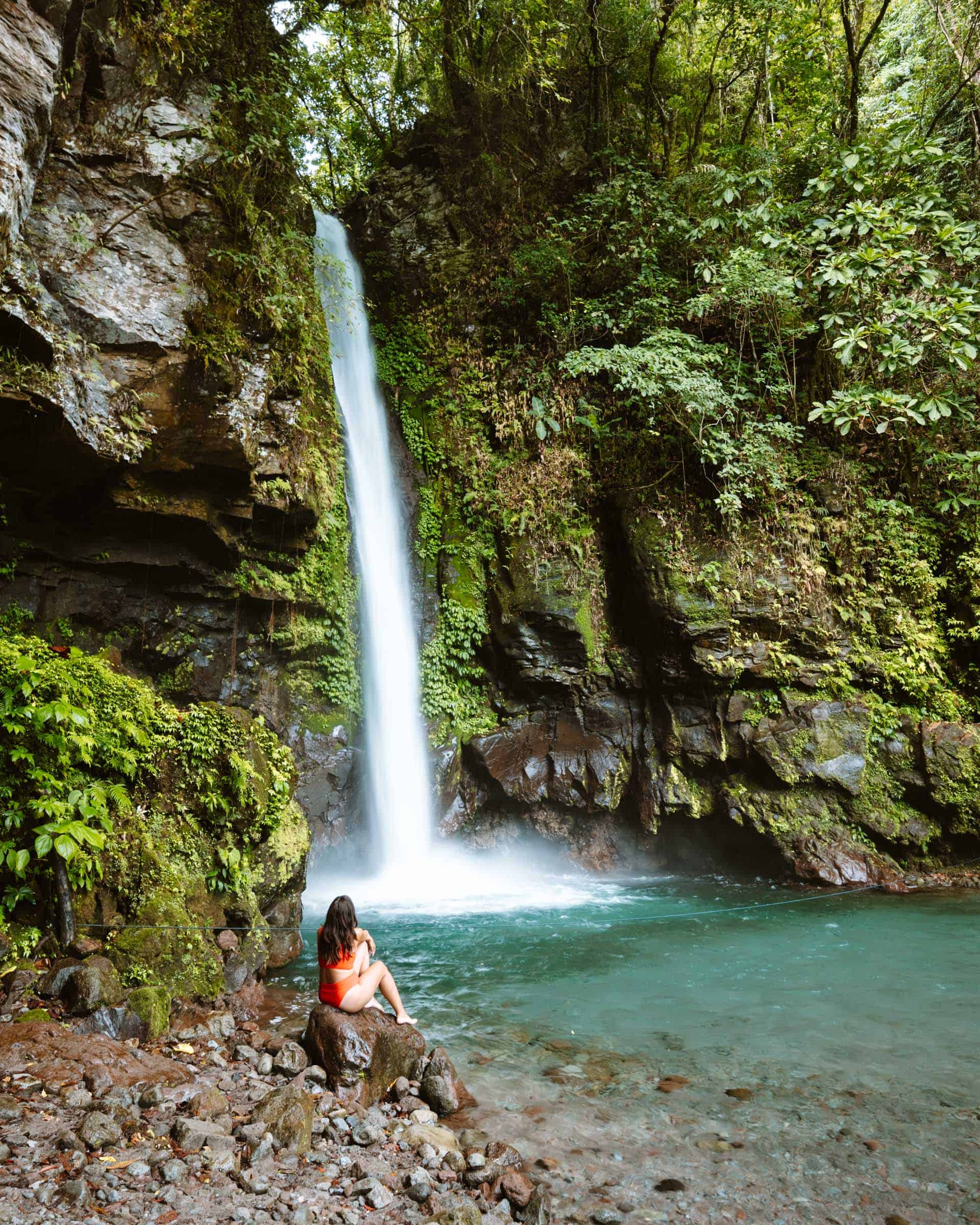
Complete List of Camiguin Tourist Spots
Sunken Cemetery
Every time we snorkel in the Philippines, it feels like our minds are blown all over again. Just when we think it can’t get any better, we stumble upon another incredible spot. This time, it was the Sunken Cemetery.
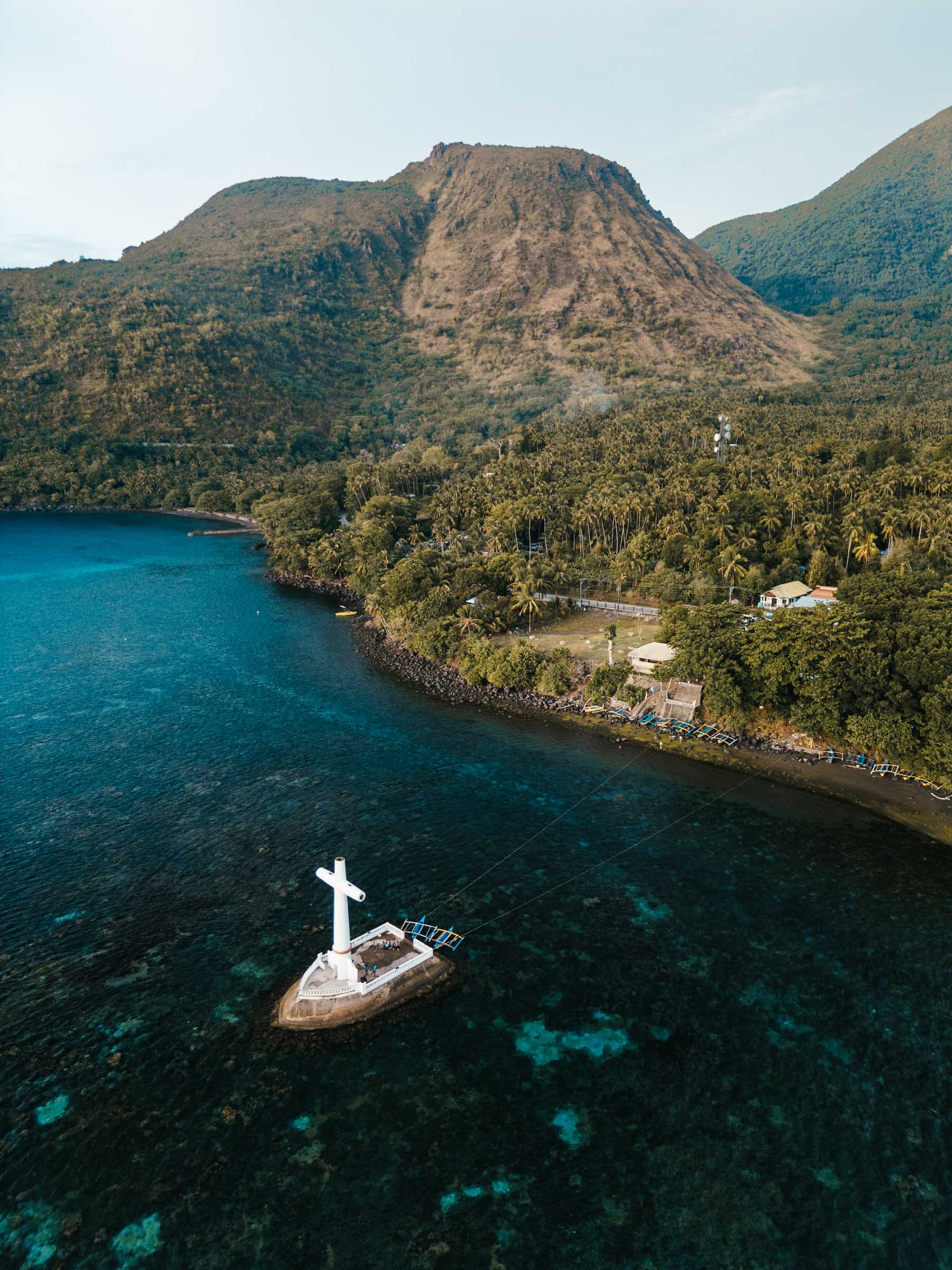
We first visited the Sunken Cemetery at sunset. The viewpoint is easy to find, right off the main road, and free to enter. From there, you can see the cross rising out of the sea, but aside from that, the only other thing to do there is browse a few souvenir shops.
If you want to visit the Sunken Cemetery up close, you can take a boat ride there. The cross sits on a concrete platform in the ocean and is a neat photo op.
But while we were eating dinner one night, we heard from some locals that the real highlight of the Sunken Cemetery lies beneath the ocean. You can visit the old cross underwater and snorkel next to giant clams in their natural habitat. Once we heard this, we knew we had to snorkel there ourselves.
Once we got in the water it didn’t take long until we were in a sea of endless coral. There were tons of fish swimming around and colorful details lit up the sea floor.
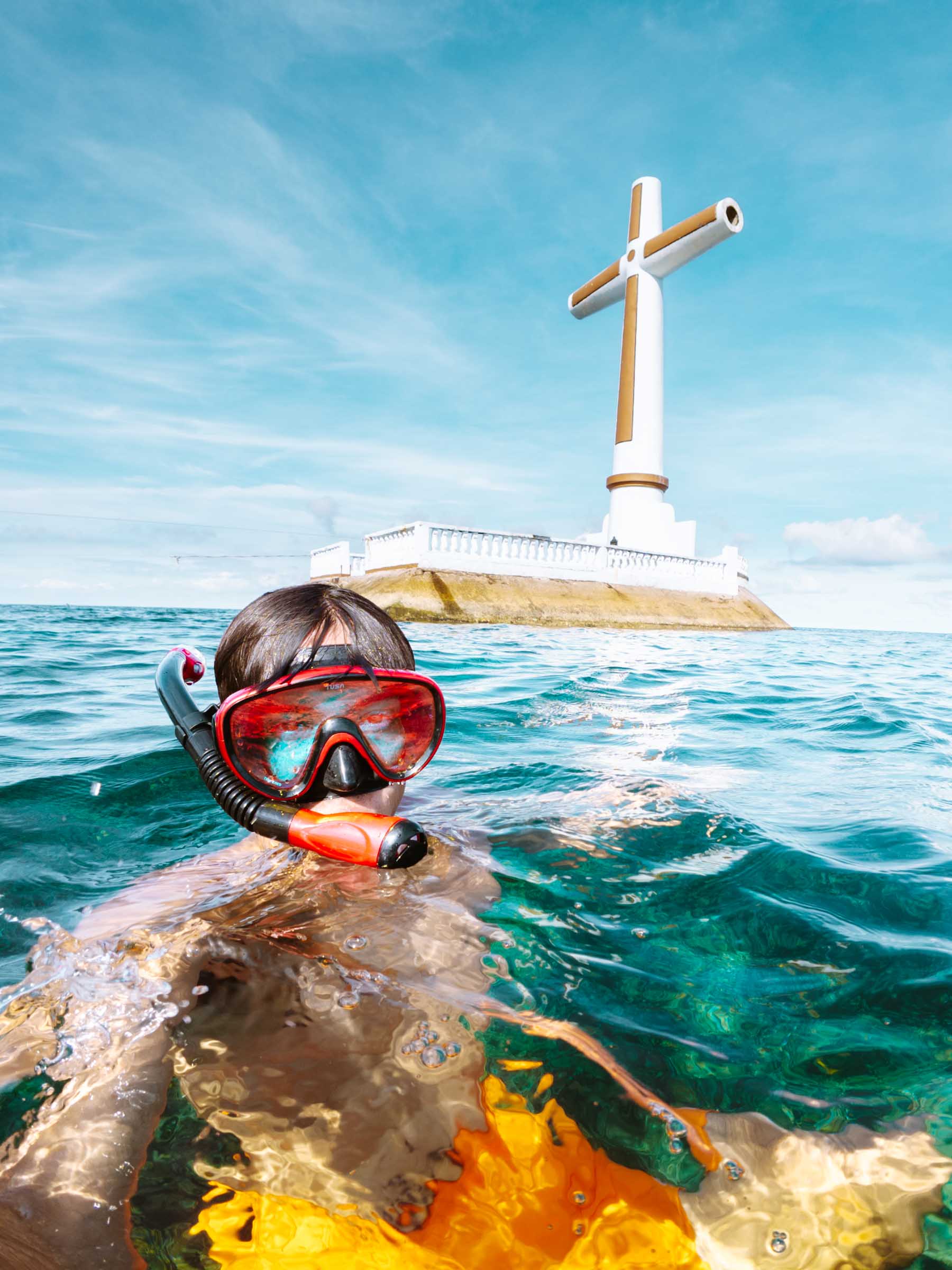
After swimming over the reef, we finally reached the giant clams. I was surprised by how huge they were—they really live up to the name “giant.” Several clams were sitting on the sea floor.

Our next stop was the old cross, which was replaced and now rests in the ocean. As we swam toward it, the tide began to rise and the current got stronger, making it hard to swim in the water. By the time we reached the old cross, waves had started rolling in, so we had to be careful around the massive concrete cross.
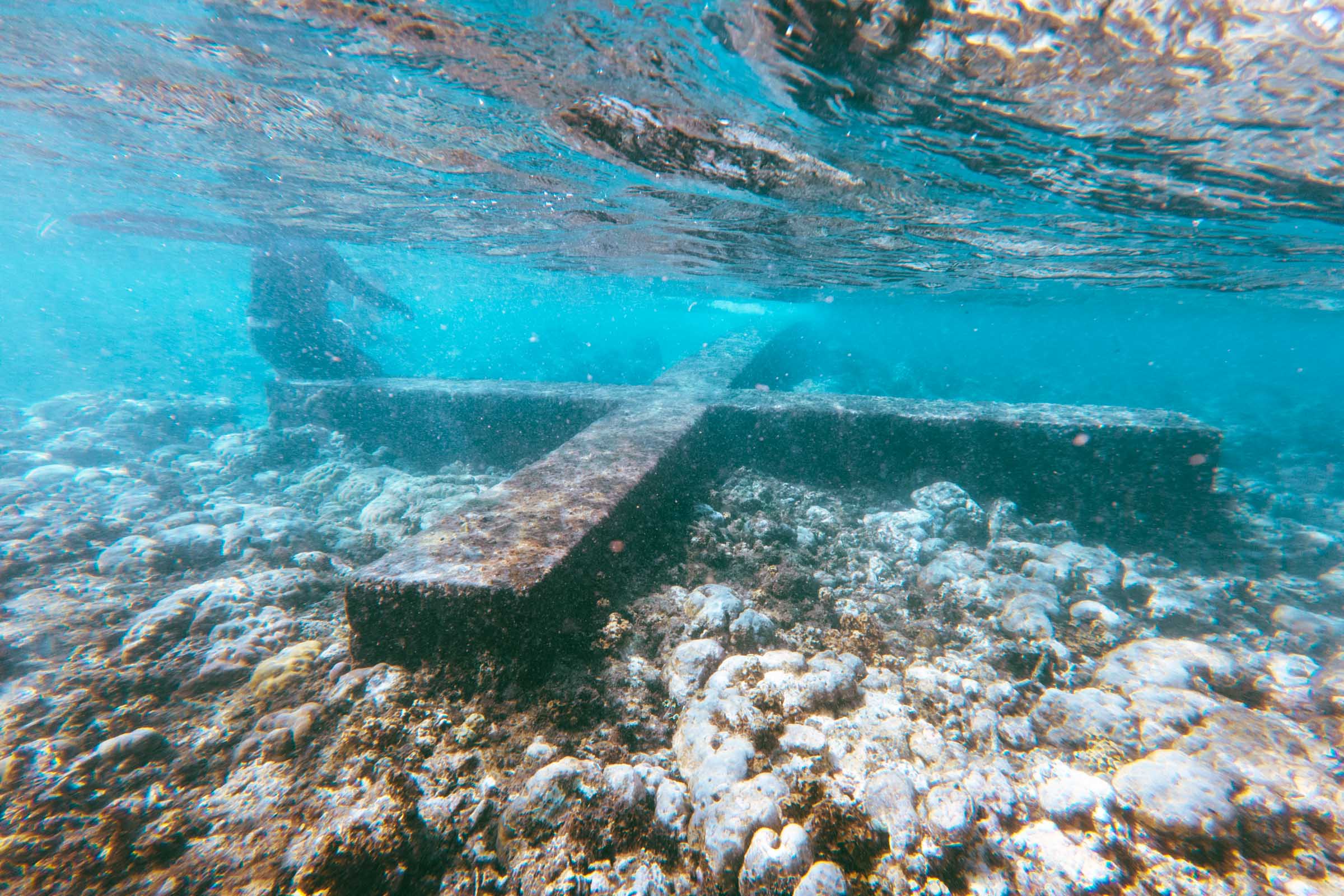
The swim back to shore was tiring. With the strong ocean current and the long distance, we were worn out by the time we finally made it back.

Read our full blog post: The Sunken Cemetery in Camiguin: Complete Guide
White Island
White Island is one of our favorite island-hopping adventures in the Philippines. The island is actually a sandbar and is located just a short boat ride from Mambajao.

White Island stretches about half a mile, and the best time to visit it is during low tide when the sandbar is fully exposed. Since the low tide times vary, it’s a good idea to check local tide charts for Mambajao before planning your trip. For us, the low tide happened to be in the morning, so we visited White Island early, taking a quick 15-minute boat ride from Barangay Yumbing in Mambajao.
The boats to White Island operate on a pretty organized system. You start by heading to the White Island Ferry Terminal, where you pay for your ferry ride and are assigned a boat number. Each boat is numbered, and you’ll take the same boat back when returning from the island.
The boats can hold up to six people, so we teamed up with two others we met while waiting in line to split the cost. The only catch is that everyone needs to take the same boat to and from the island, but since we were flexible with timing, it worked out fine for us.
When we stepped onto White Island, we found a pristine white sandbar with clear waters and views of Camiguin’s Mount Hibok-Hibok in the distance. The island is actually quite large, so it was easy to find our own area to chill between swim sessions.
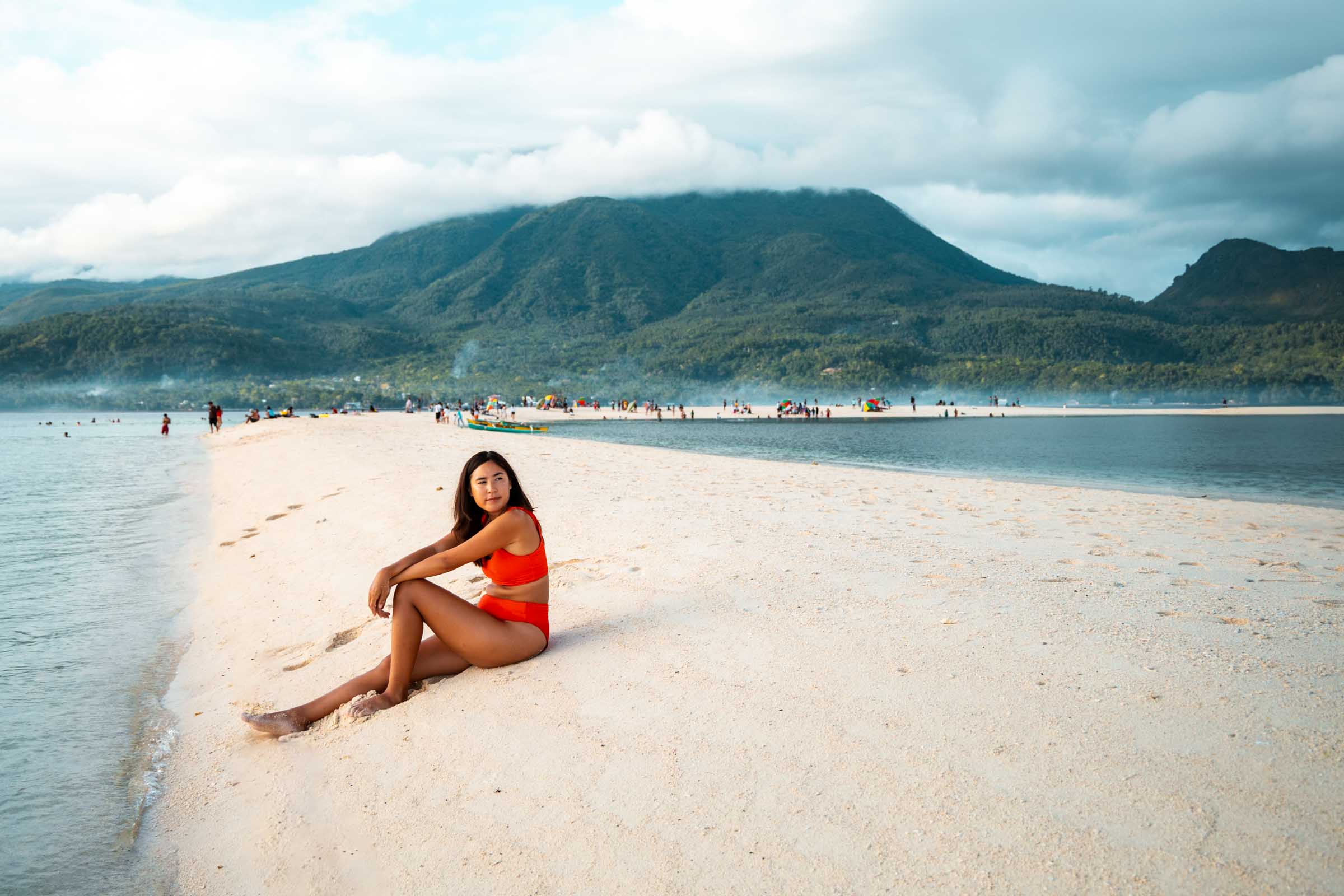
White Island has no shops or vendors, so make sure to bring your own food, drinks, sunscreen, and any other beach essentials for a few hours. The only thing you can buy on White Island are fresh sea urchins, caught by local divers who sell them as snacks. I tried one while sitting on the beach. It had a very fishy taste and is definitely not for everyone.

Read our full blog post: White Island in Camiguin: Complete Guide
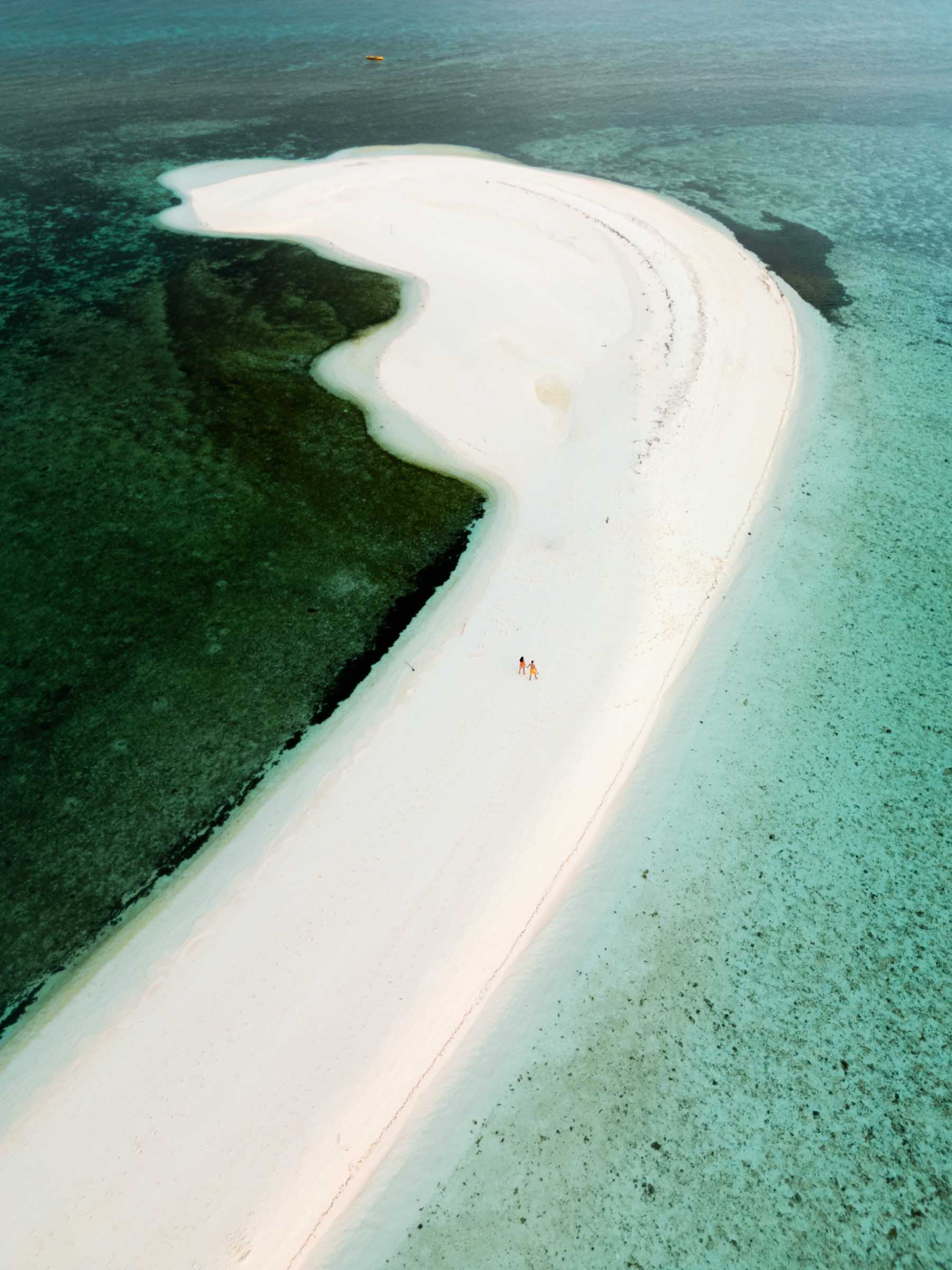
Katunggan Park
We didn’t have high expectations for Katunggan Park, but it ended up being one of our favorite spots in Camiguin.
Katunggan Park consists of a series of boardwalks that zigzag through the mangroves along the coastline. At first, we thought it was just a pleasant place for a quick stroll. But as we walked over the boardwalks we found a few huts that extend out over the ocean. I had seen these types of structures before, but I didn’t realize they existed in the Philippines. The water below the huts was so clear that we could see the bottom of the ocean.
The huts are available to rent for 150 pesos for three hours, and we saw many local families posted up in them, enjoying food and relaxing for the afternoon.
The huts also make for a good jumping-off point into the water. We met a friendly family who invited us into their hut and we hung out with them while swimming in the ocean with their children. They told us that the park is only busy on the weekends, and we were lucky that we just so happened to visit during high tide because that’s the best time to swim there.
After swimming we had lunch at the restaurant at the entrance of the park. Katunggan Park costs 50 pesos per person to enter.

Read our full blog post: Katunggan Park in Camiguin: Complete Guide
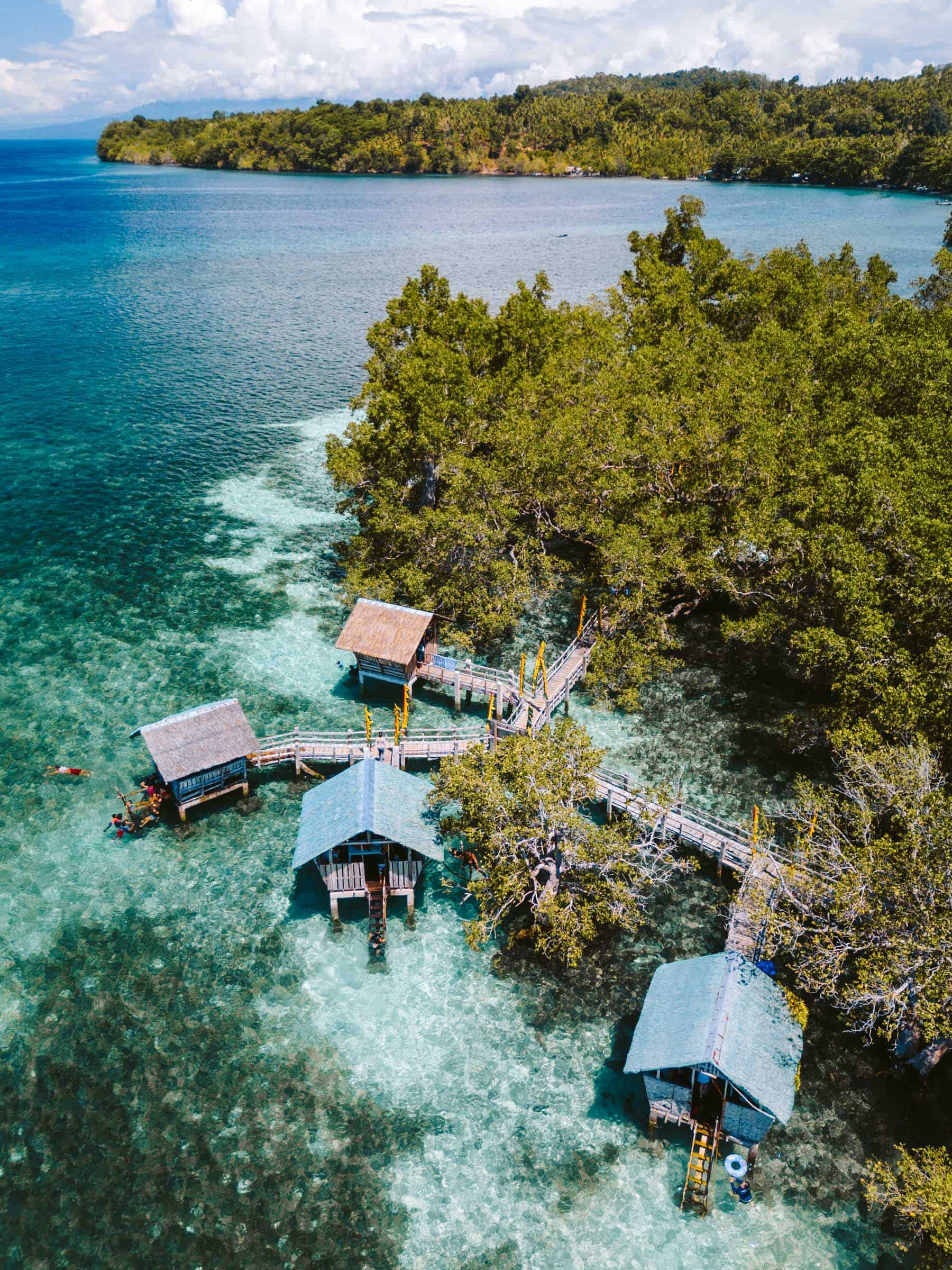
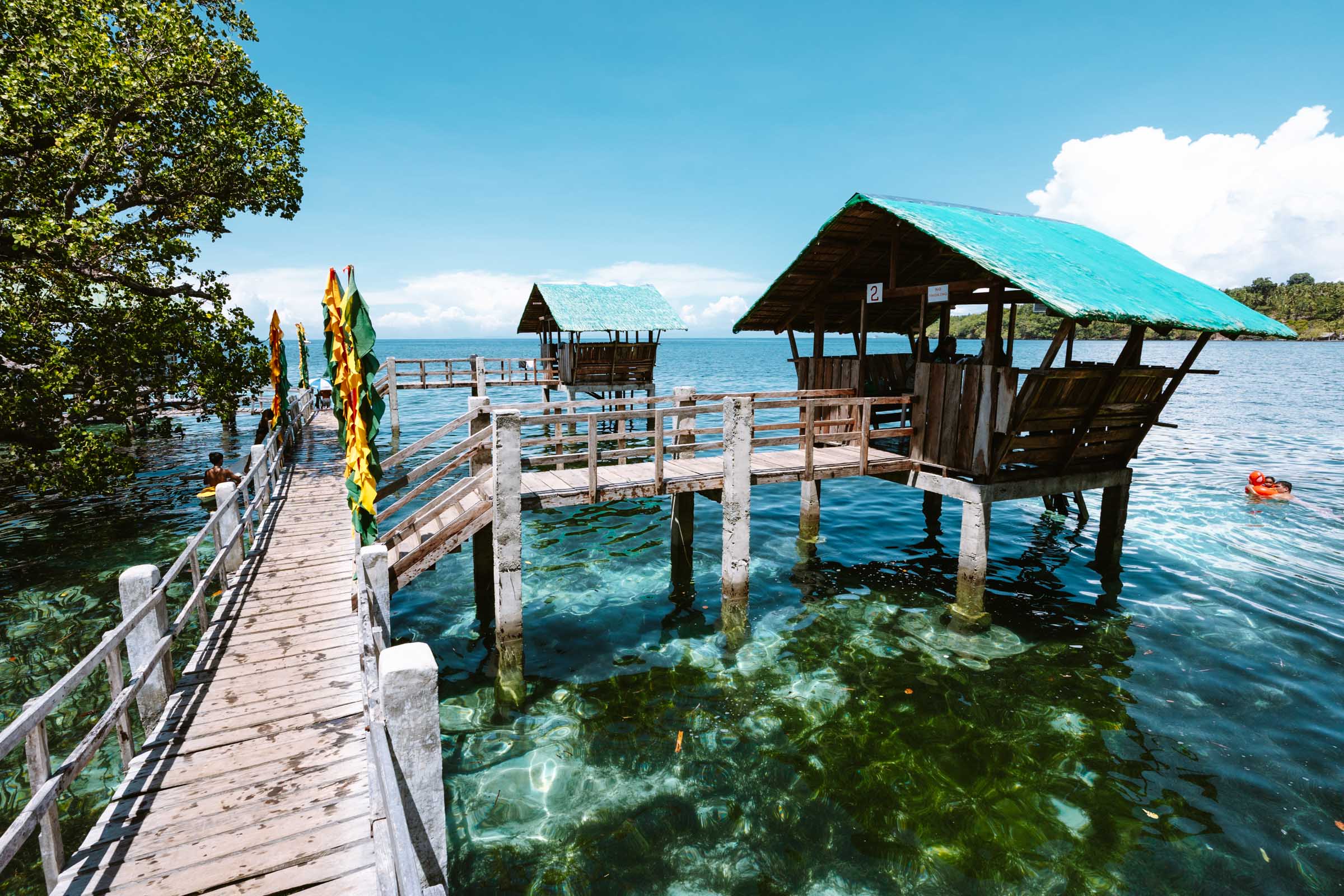
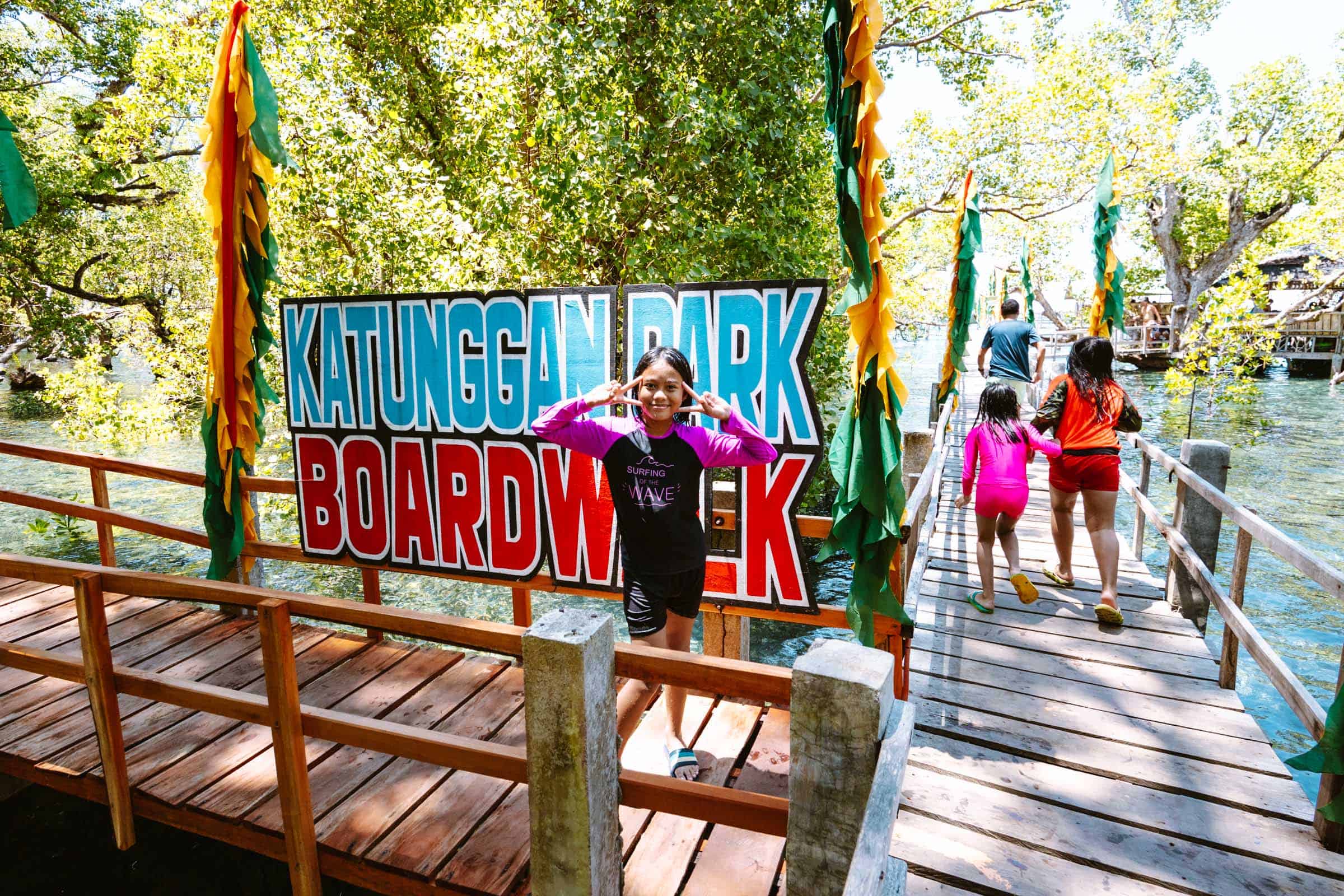
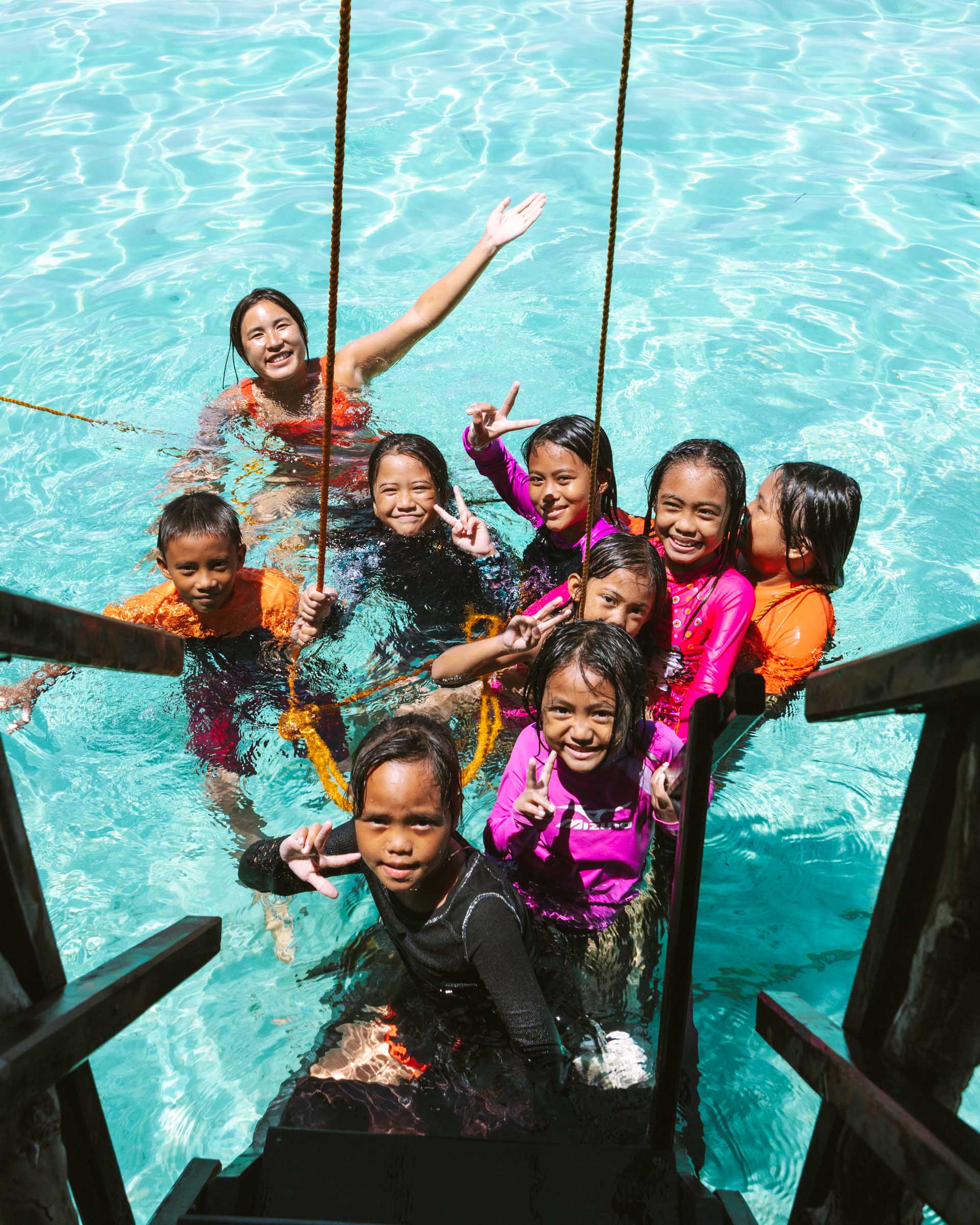
Mantigue Island
Just off the east coast of Camiguin is Mantigue Island, a protected area and sanctuary for marine life. The island is known for its marine life, and the south side of the island has a steep underwater drop-off with some of the most epic reefs we’ve snorkeled.
The boats to Mantigue Island depart from Mahinog in southeast Camiguin, and the boat ride to Mantigue only takes about 20 minutes. When the boat reached Mantigue Island we stepped onto a long white sand beach that wrapped around it. Apart from a building with a shop and a restaurant, there wasn’t much on the island besides trees and a white sandy beach.
We put on our snorkels to see what we could find underwater. I didn’t see anything close to shore but as I swam out I started to see little bits of reef dotting the sea floor. Suddenly, I reached a massive underwater drop-off with a huge reef and massive schools of fish swimming around.
I dove down a few times to get closer to the reef and check it out. I couldn’t believe how many fish there were, and I was the only person out there snorkeling. The reef kept going and I was swimming all over the place to see what was around every corner. Normally I would get tired from all the swimming. But at this reef, I was like a kid in a candy store.
After snorkeling we took some time to explore the island. I was starving and luckily we met some divers who just got out of the water. They caught a bunch of sea urchins. I had already tried one a few days earlier at White Island and wasn’t a huge fan of it, but I was so hungry that I bought one right there and ate it while standing on the shoreline.
We spent so much time snorkeling at Mantigue Island that we completely wore ourselves out. By the end of our adventure, we were ready to head back, feeling accomplished and grateful for the incredible marine life we encountered in such an awesome place.

Read our full blog post: Mantigue Island in Camiguin: Complete Guide
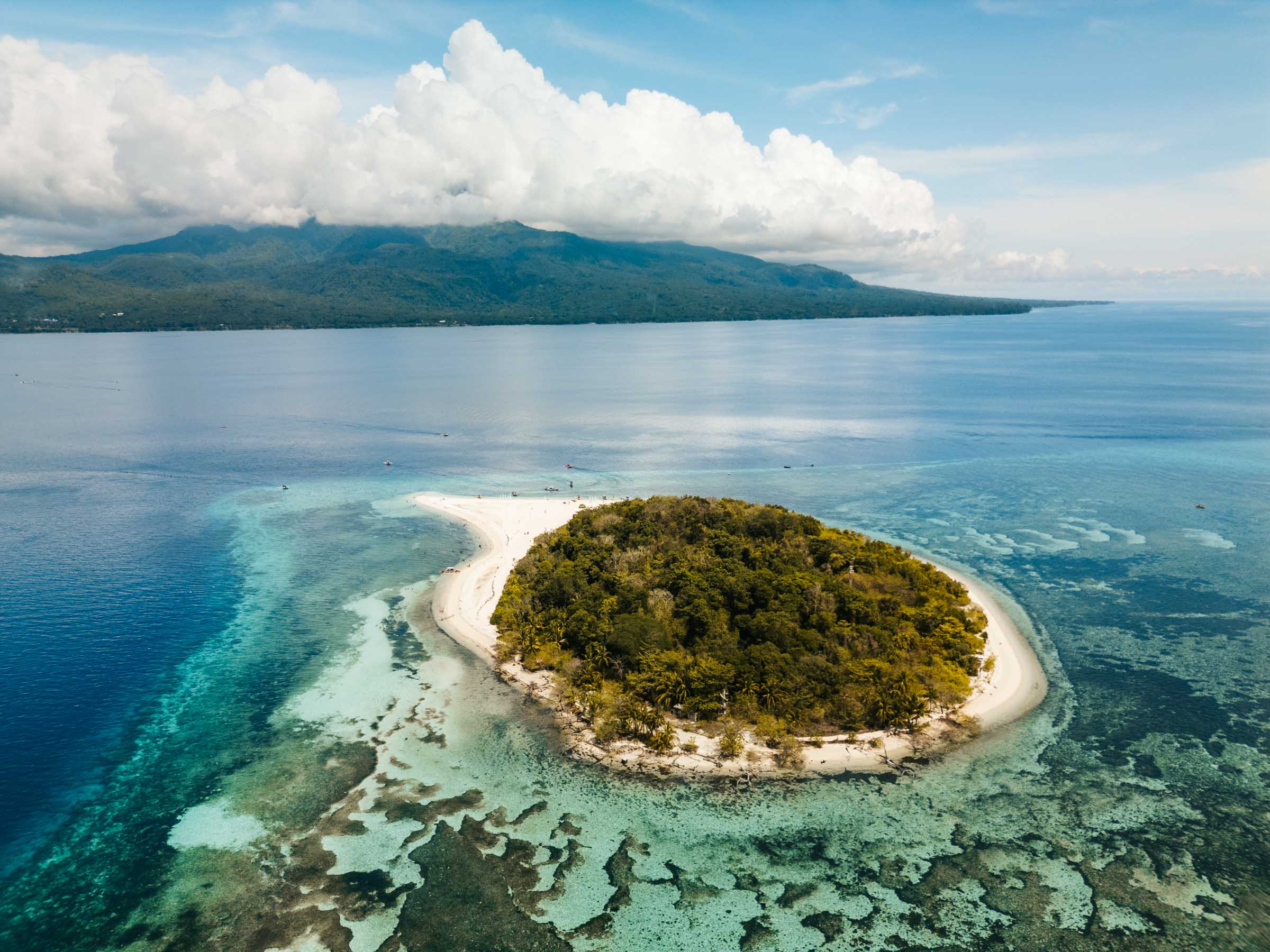
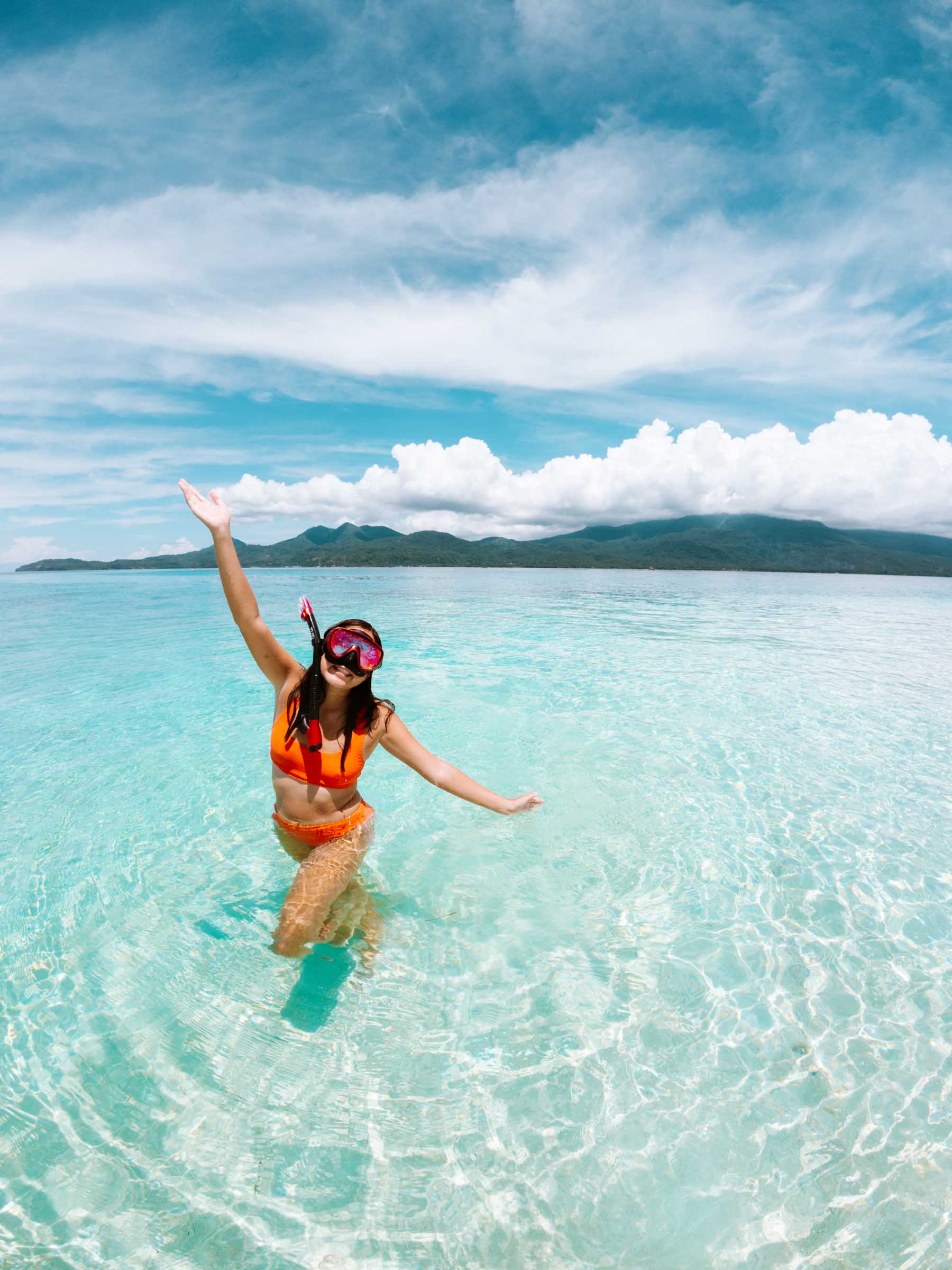

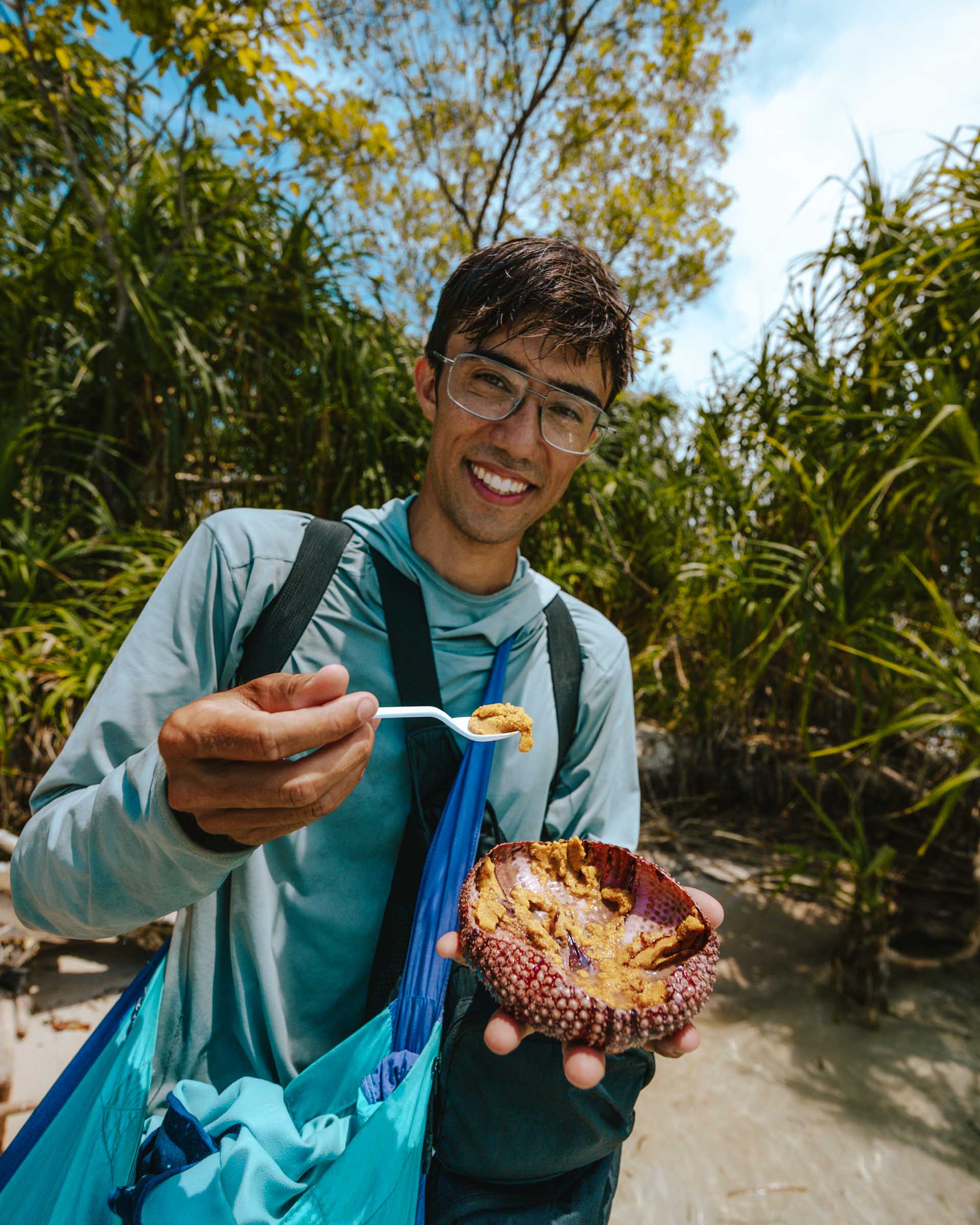
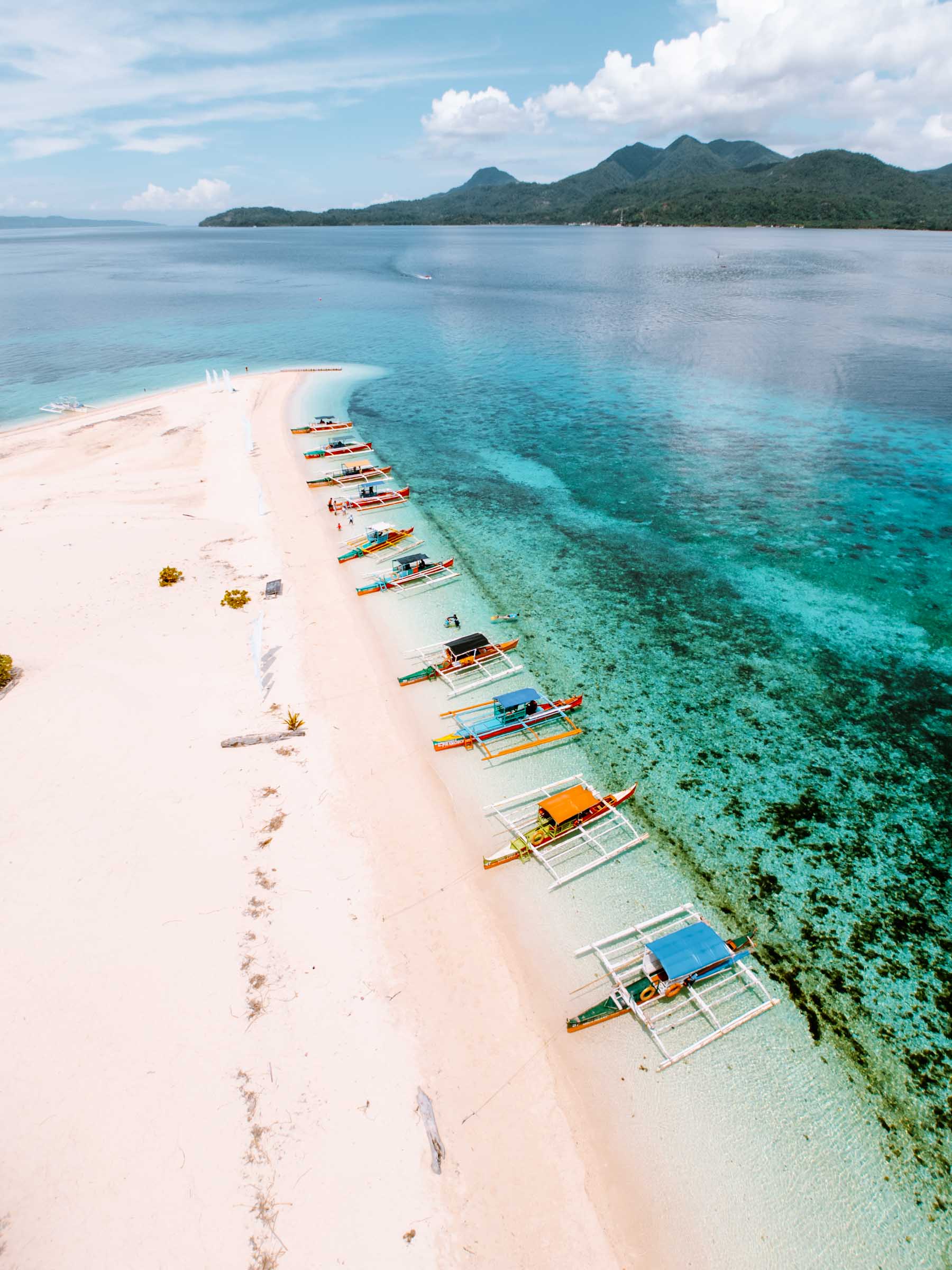
Bura Soda Water Pool
There’s no shortage of cold springs in the Philippines, but few can claim to be a soda water spring. That’s the case of the Bura Soda Water Pool in Camiguin. This natural cold spring is fed by soda water and has two large swimming pools, where many people go to cool off.
While you’re not allowed to drink directly from the pool itself, there are designated faucets where you can fill up your bottle and taste the soda water. We drank some of it and it certainly has the slightly sweet taste of soda water, but it doesn’t have the bubbles. It tastes like if you left a can of soda water out overnight and drank it the next day.
Surrounding the pool are huts and seating areas where you can set down your things while you go for a swim.
The Bura Soda Water Pool is located about a 35-minute motorbike ride from Mambajao, and the entrance fee is 150 pesos. It’s a great spot to relax and experience something unique.

Read our full blog post: Bura Soda Water Pool in Camiguin: Complete Guide
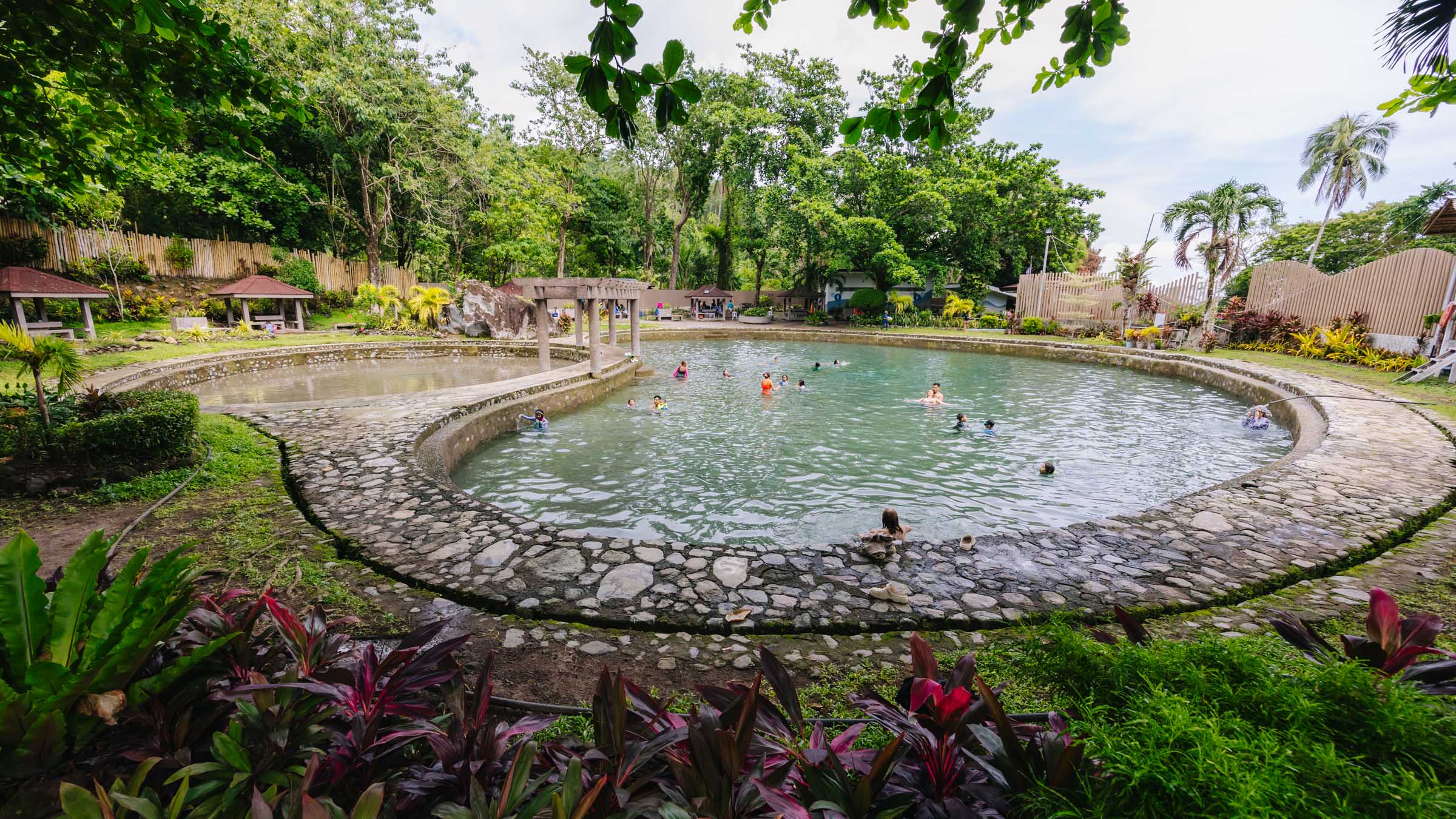
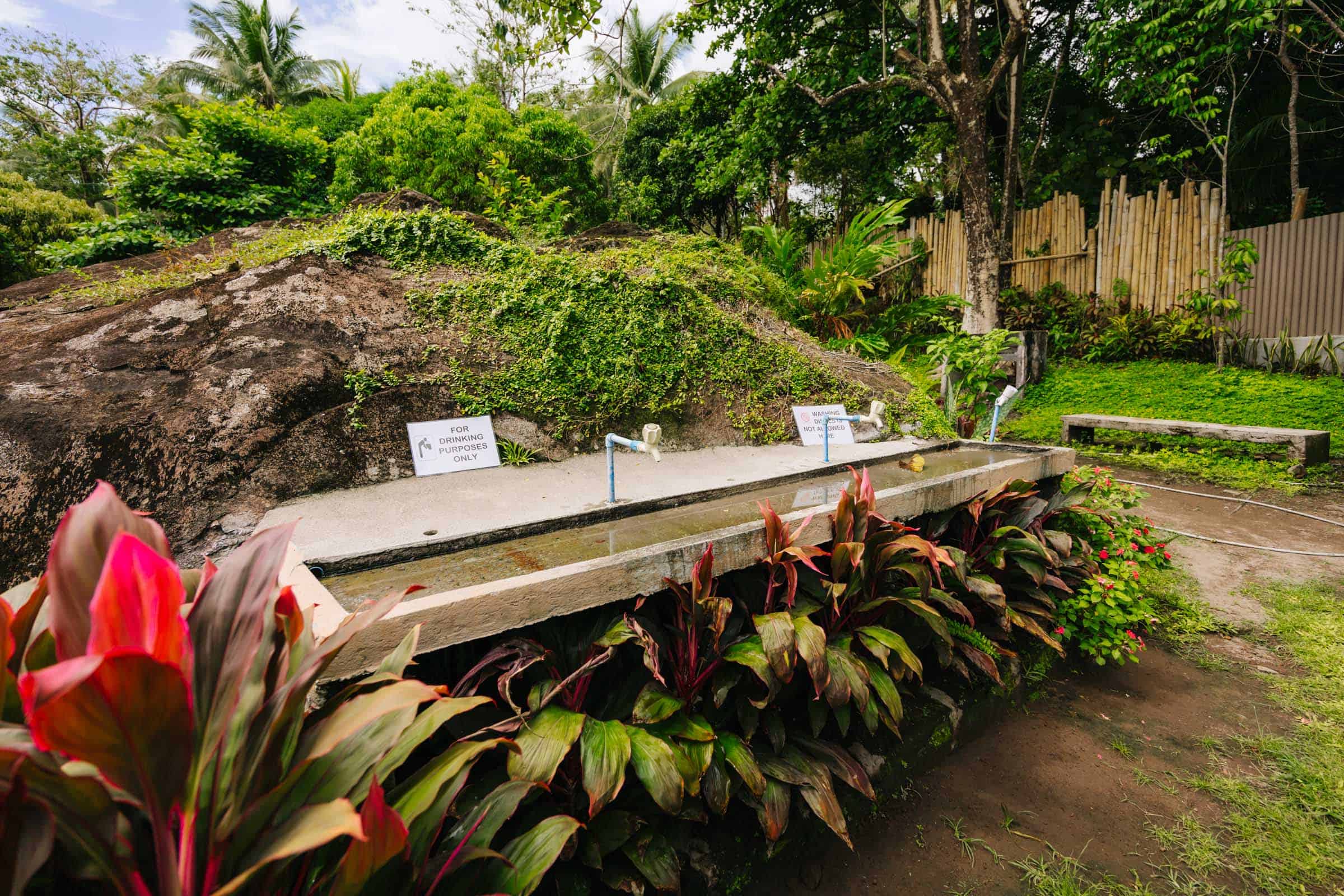
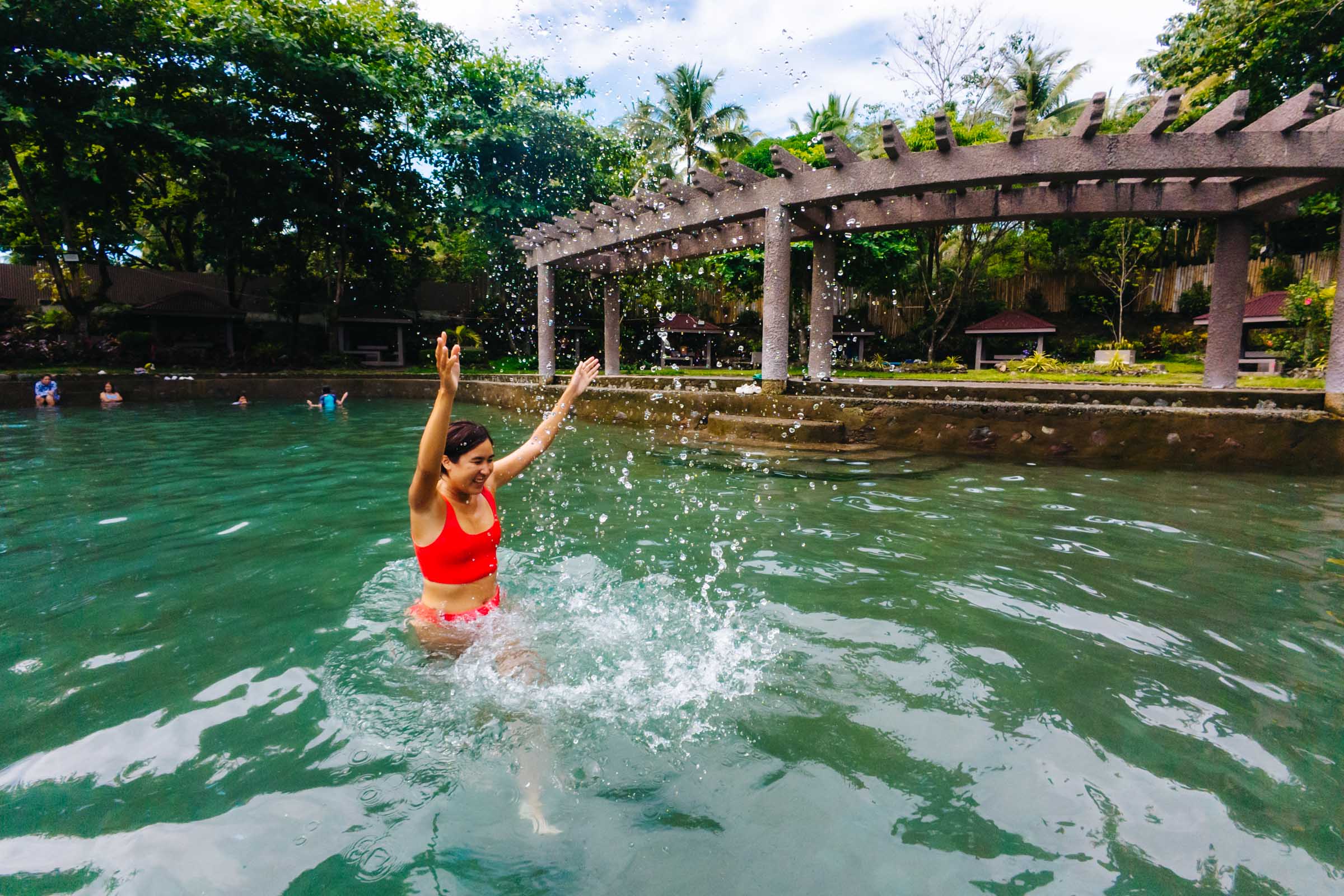
Our Free Camiguin Google Maps Locations
Do you need a handy map with all our Camiguin locations from this list? We’ve got a FREE Google Map with all the Camiguin locations in this post (plus a LOT more). Sign up in the box below and we’ll deliver it right to your inbox, plus our top tips to help you plan your Camiguin adventure.
Sa-ay Cold Spring
Sa-ay Cold Spring was the first place we visited in Camiguin and it certainly made an impression. When we pulled up to it, we expected to find some sort of entrance fee or gate. But to our surprise, it was completely free so we just walked up and jumped right in.
There are two pools at Sa-ay Cold Spring – an upper and a lower one. The upper one is a bit deeper and better for swimming, while the lower one is good for wading around.
We enjoyed some time at both pools, swimming, chatting with locals, and playing with kids who were splashing around. After speaking with the locals, we found out that the cold spring is fed by the same water source that provides drinking water for the village.
Afterward, we decided to explore the stream located just behind the cold spring. The stream flows through a beautiful area under the forest canopy. It reminded me of some of the streams back home in Hawaii. There are a few areas where people have moved the rocks around to create little nooks where you can sit and relax in the stream. We saw a few people doing just that.
On our way out, we grabbed a snack at one of the sari-sari stores on the road next to the cold spring before heading down the road to our next adventure.

Read our full blog post: Sa-ay Cold Spring in Camiguin: Complete Guide
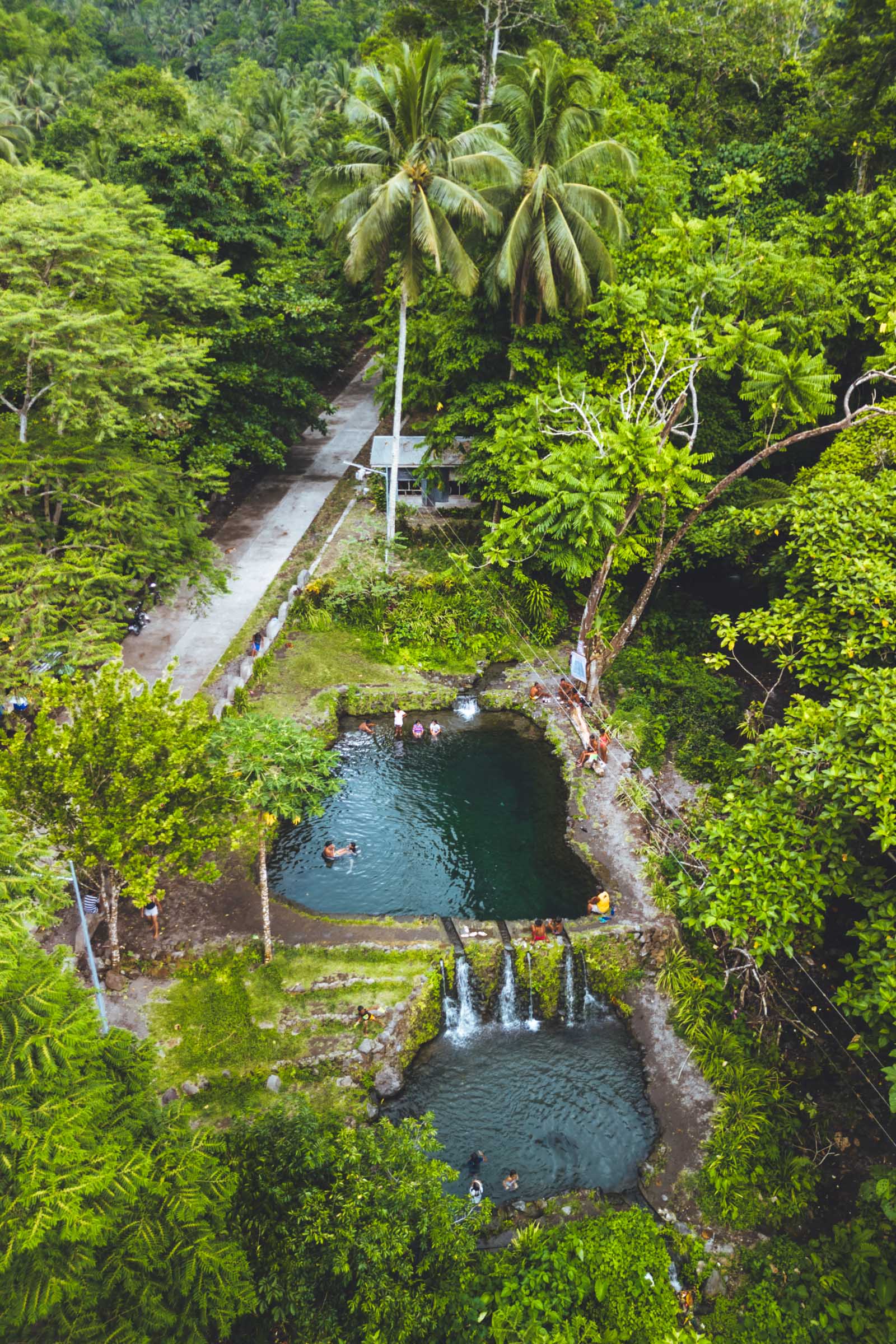
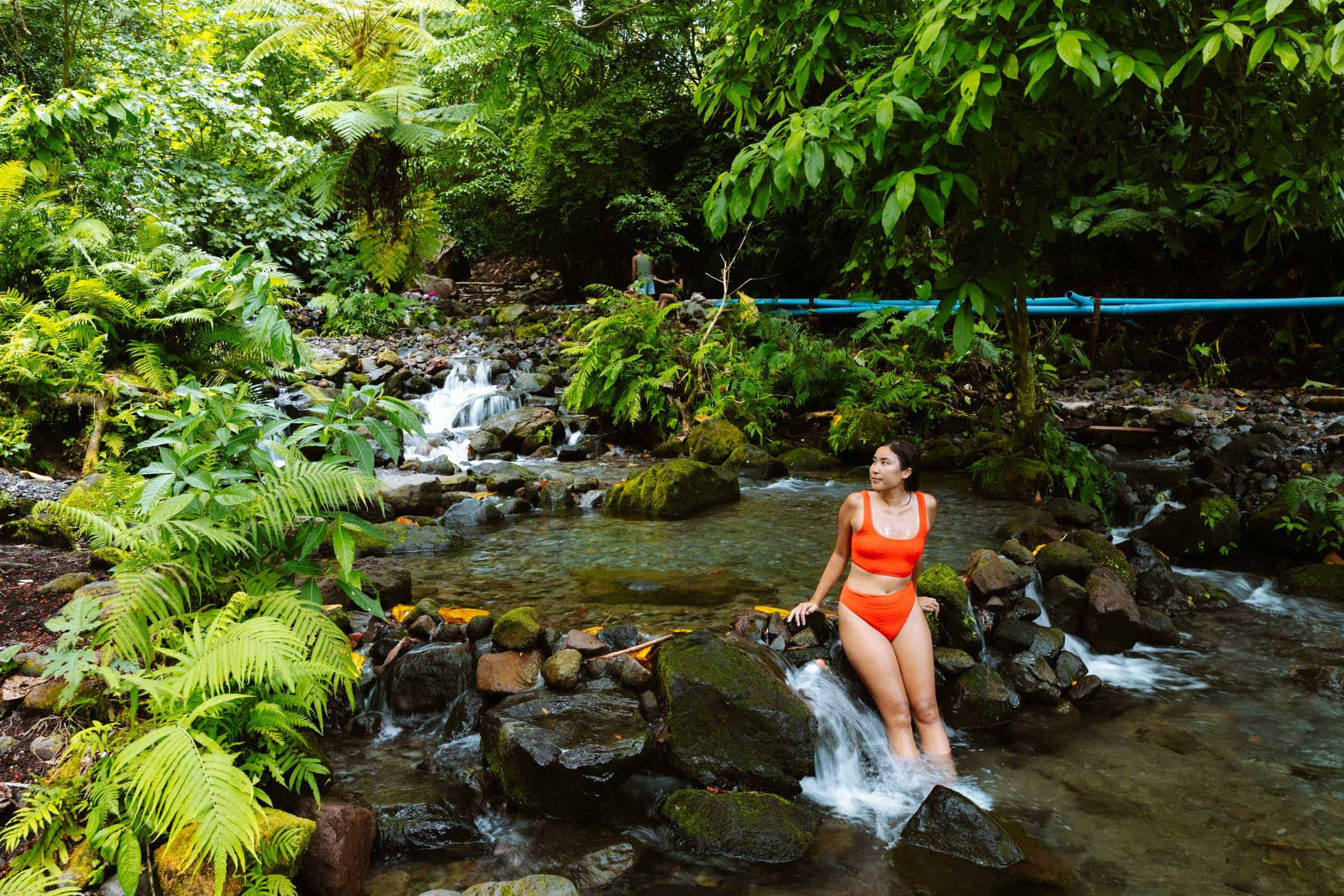
Tuasan Falls
Tuasan Falls is one of the top things to do in Camiguin and in our opinion it’s the best waterfall in Camiguin. It consists of a single cascade that’s 20 meters tall, falling over a rock face into a clear pool of water below. The waterfall is surrounded by lush jungle which adds to its beauty.
Tuasan Falls has a huge parking area and is easy to get to. The roads leading to the waterfall are in good shape and we had no problem finding it. After parking our motorbike, we bought a coconut and some snacks from one of the sari-saris in the parking lot before paying 75 pesos per person to go through the gate to the waterfall.
Even though it’s not the biggest, Tuasan Falls is in our opinion the best waterfall in Camiguin. The waterfall is picture-perfect, but it’s more than just a photo spot as you’ll find everyone swimming in the crystal-clear pool of water at the base of the falls.
Once we jumped into the pool, we immediately felt the power of the waterfall crashing into the pool. It reminded me that nature can sometimes be both beautiful and powerful at the same time.

Read our full blog post: Tuasan Falls in Camiguin: Complete Guide
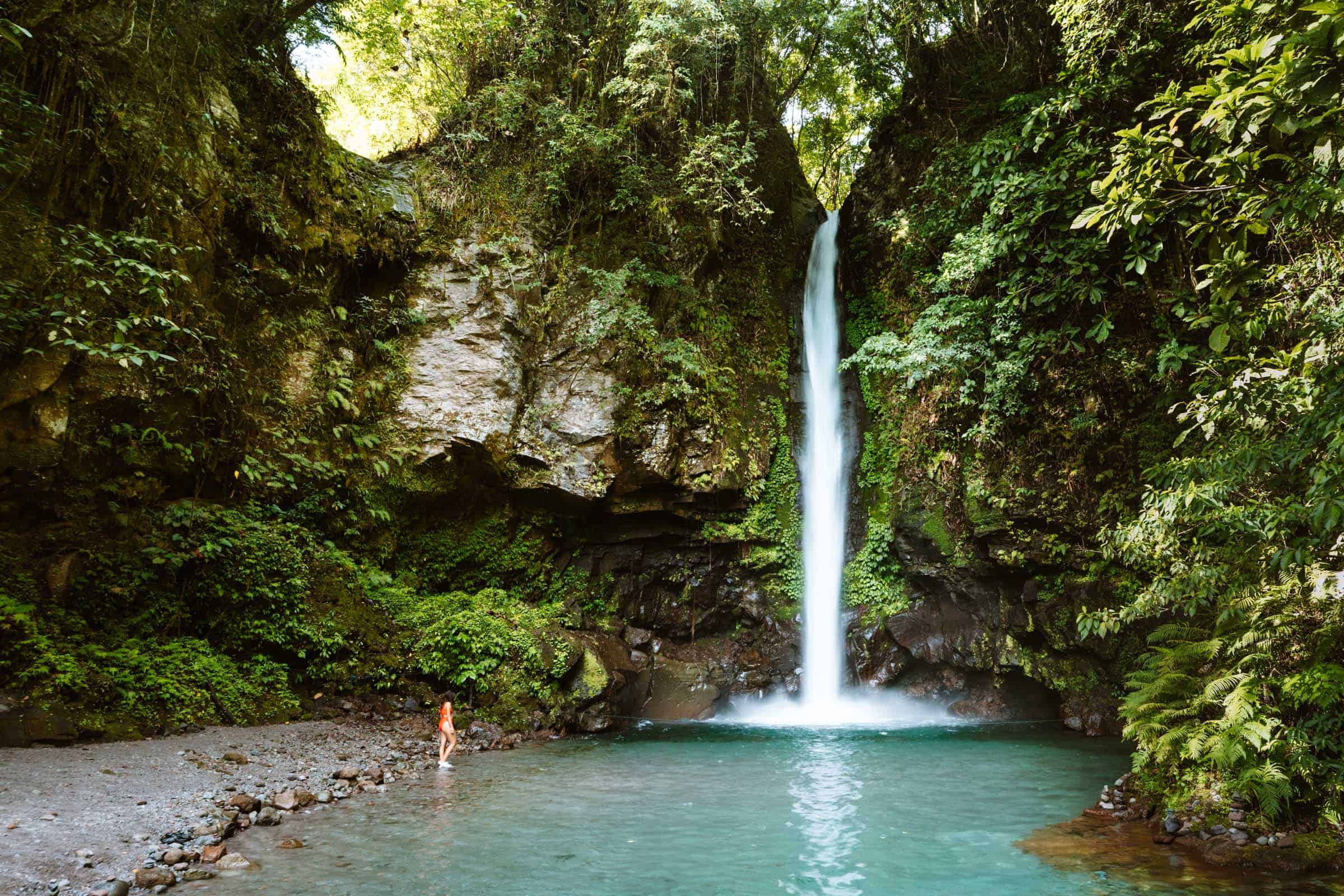
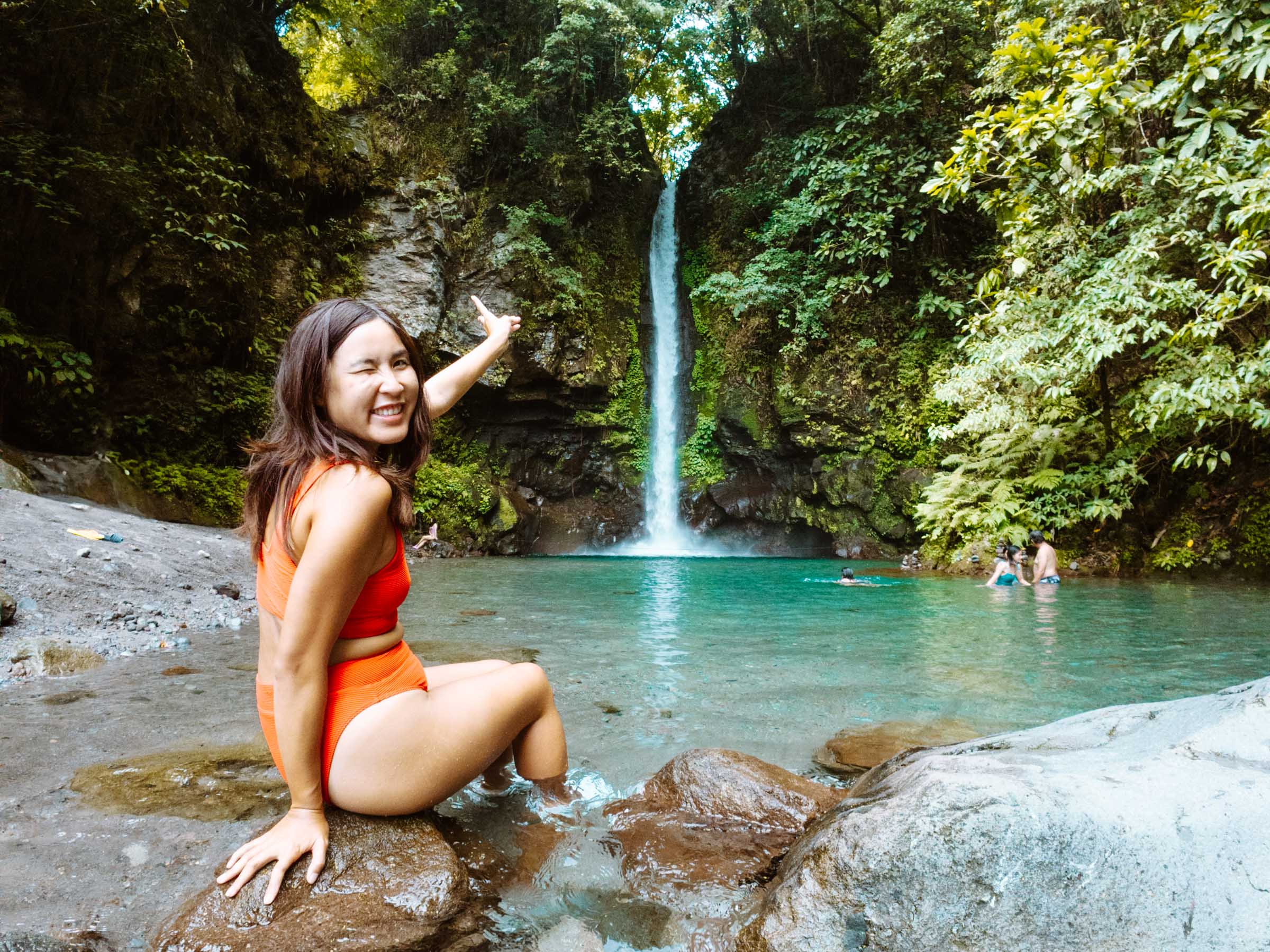

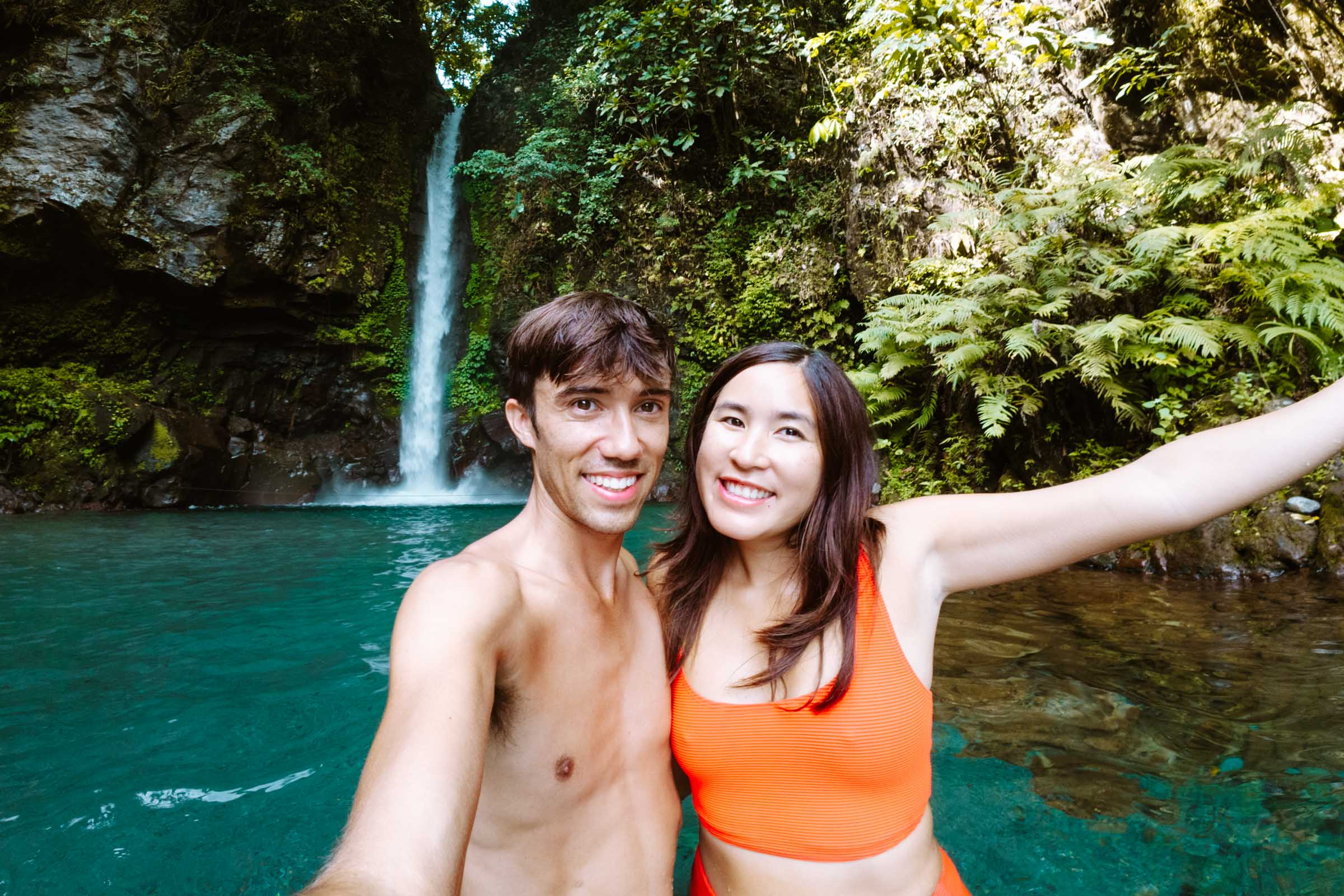
Ardent Hot Spring
We visited Ardent Hot Spring one evening after a full day of exploring Camiguin. It’s not far from Mambajao, and the road takes you through a village and then winds into a dense forest, making the journey feel like an adventure in itself. It rained earlier in the day, so the sight of the hot spring surrounded by lush rainforest really brought the tropical vibes.
We reached Ardent Hot Spring when it was getting dark, so I was surprised to find that there were plenty of locals there swimming and enjoying the springs. We chatted with some of them and found out that Ardent is especially popular in the evening because the cooler nighttime air makes the water temperature just right for relaxing. It’s too hot to enter during the day, but when the sun goes down the water temperature is just right.
So, about the water temperature at Ardent Hot Spring. I got to talking with a local man while we were in the hot spring. He told me that the water from the hot spring used to be much hotter. But after an earthquake altered the flow of the hot spring, the temperature isn’t as hot as it once was. These days, the water at Ardent Hot Spring is just “warm”. I wouldn’t call it hot.
But honestly, it was the perfect temperature for us. The water was comfortable enough to lounge in without ever feeling like you needed to get out. That’s probably why it is so popular in the evening because you won’t ever get cold swimming around in it.

Read our full blog post: Ardent Hot Spring in Camiguin: Complete Guide
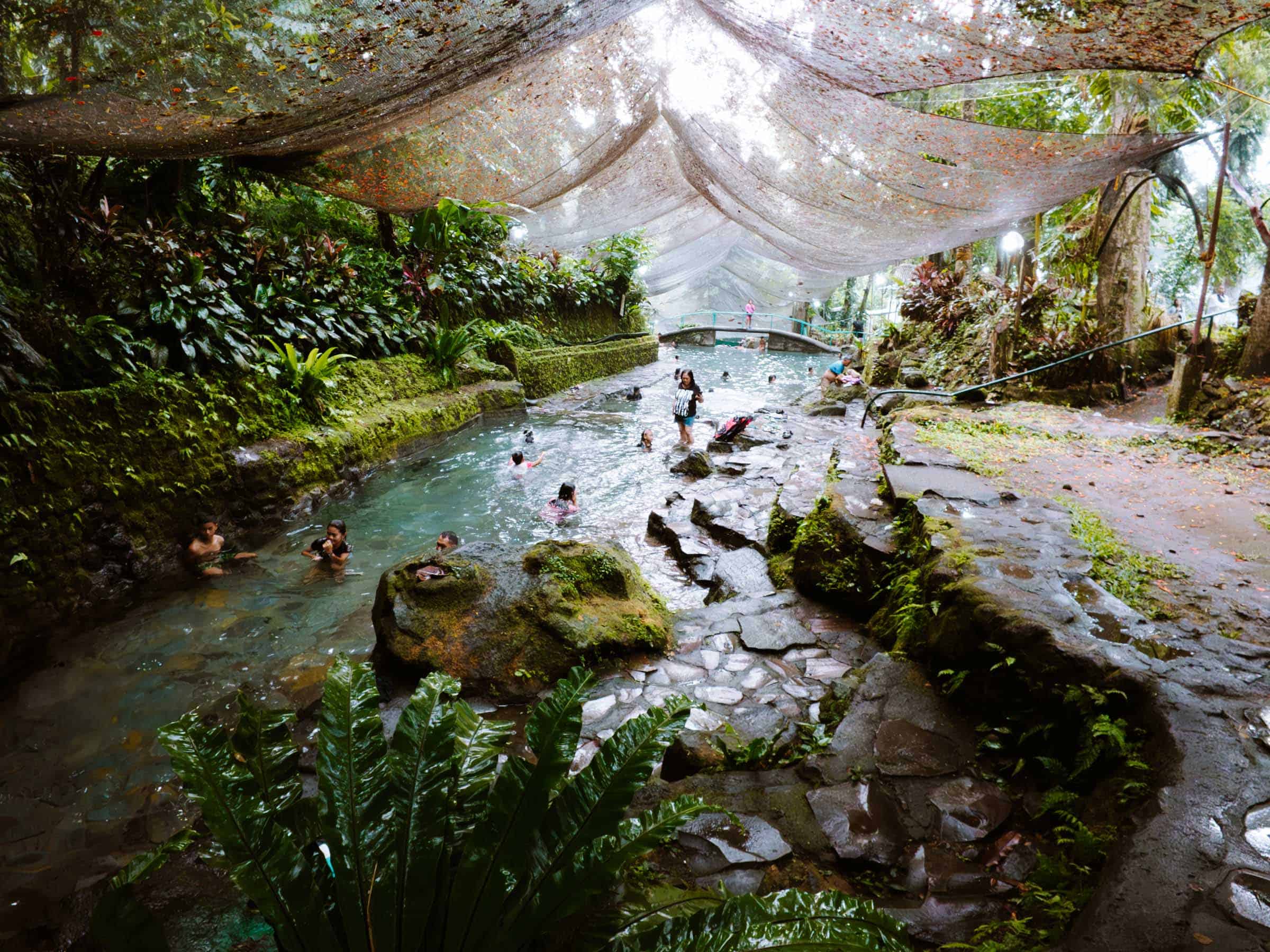

The Walkway to the Old Volcano and Stations of the Cross
Mount Hibok-Hibok’s most famous eruption was in 1871, when a volcanic fissure now called Mount Vulcan opened up and started spewing out lava. The Walkway to the Old Volcano in Camiguin is a short but steep hike along the side of Mount Vulcan.
What makes the hike unique is that it’s paired with the Stations of the Cross, with 14 life-sized statues depicting key moments leading up to the crucifixion of Jesus Christ. This adds a religious and historical layer to the hike, turning it into a spiritual journey for many visitors, especially during Lent when they make the journey as an act of devotion.
While the views from the end of the trail are decent and the hike provides a nice way to get some exercise, it isn’t particularly scenic compared to other spots on the island.
When we hiked up the walkway, it was raining, and it was a nice way to get out of the routine of going to beaches and cold springs. I was interested in hiking up to the top of Mount Vulcan, and I found the trail that branches off the walkway, but unfortunately, it was overgrown. While going up the walkway was a nice change of pace for us, I wouldn’t strongly recommend visiting it unless you’re specifically interested in a short hike or its biblical significance.

Read our full blog post: Walkway to the Old Volcano in Camiguin: Complete Guide
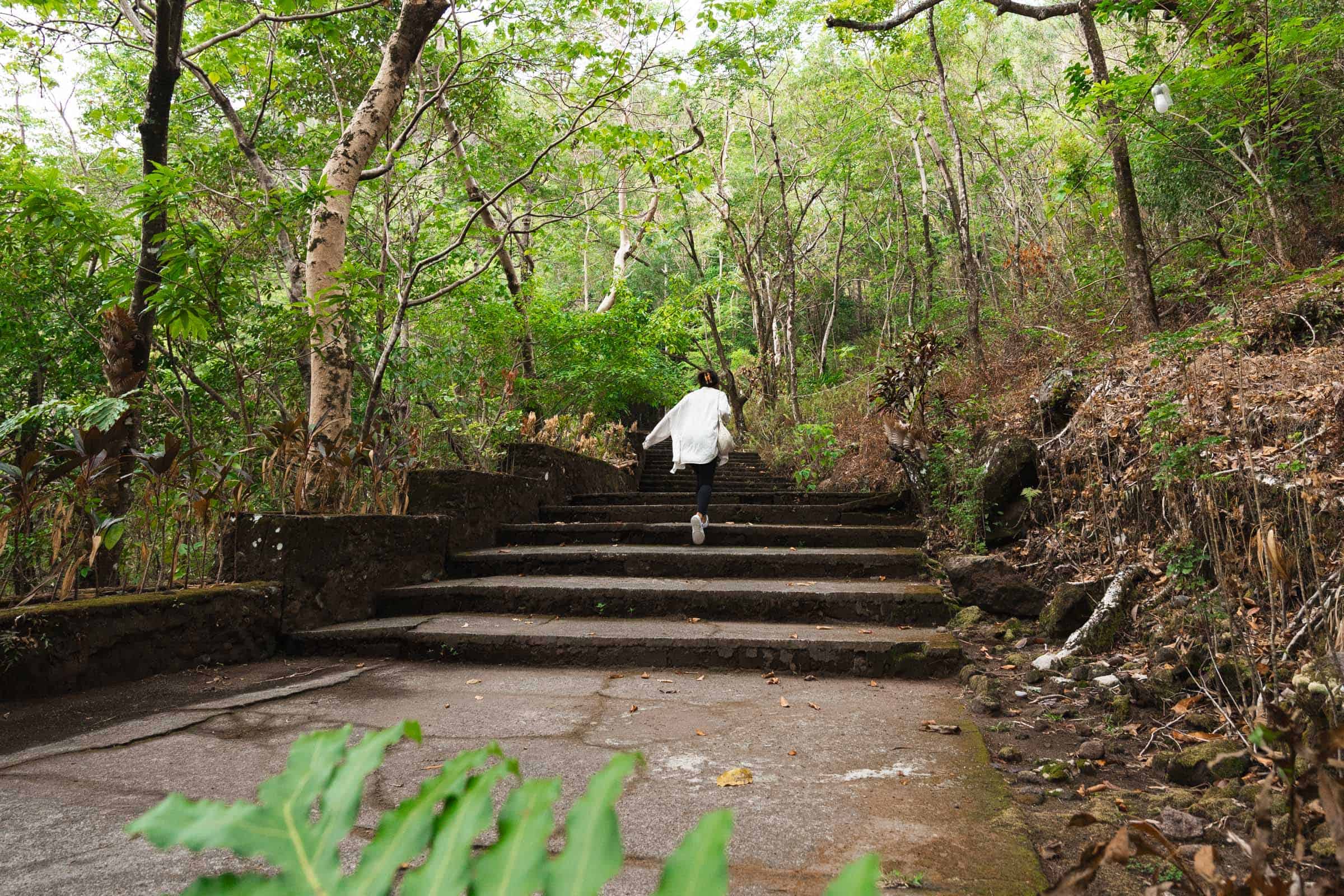

Old Church Ruins
The Old Church Ruins is another reminder of the 1871 eruption of Mount Hibok-Hibok.
Once known as Guiob Church, Mount Hibok-Hibok’s eruption left the church in ruins and buried the town of Cotta Bato.
The Old Church Ruins are easily accessible, located along the Camiguin Circumferential Road. You’ll likely pass right by them if you’re exploring the island.
We stopped by the Old Church Ruins one evening, just before closing, and while there isn’t much to do beyond exploring its old coral walls, it was worth spending a few moments there to check out the ruins and admire the giant trees that now tower over them.
While the Old Church Ruins may not be the highlight of your trip to Camiguin, it’s worth a stop there to get a sense of the history of the island.

Read our full blog post: Old Church Ruins in Camiguin: Complete Guide
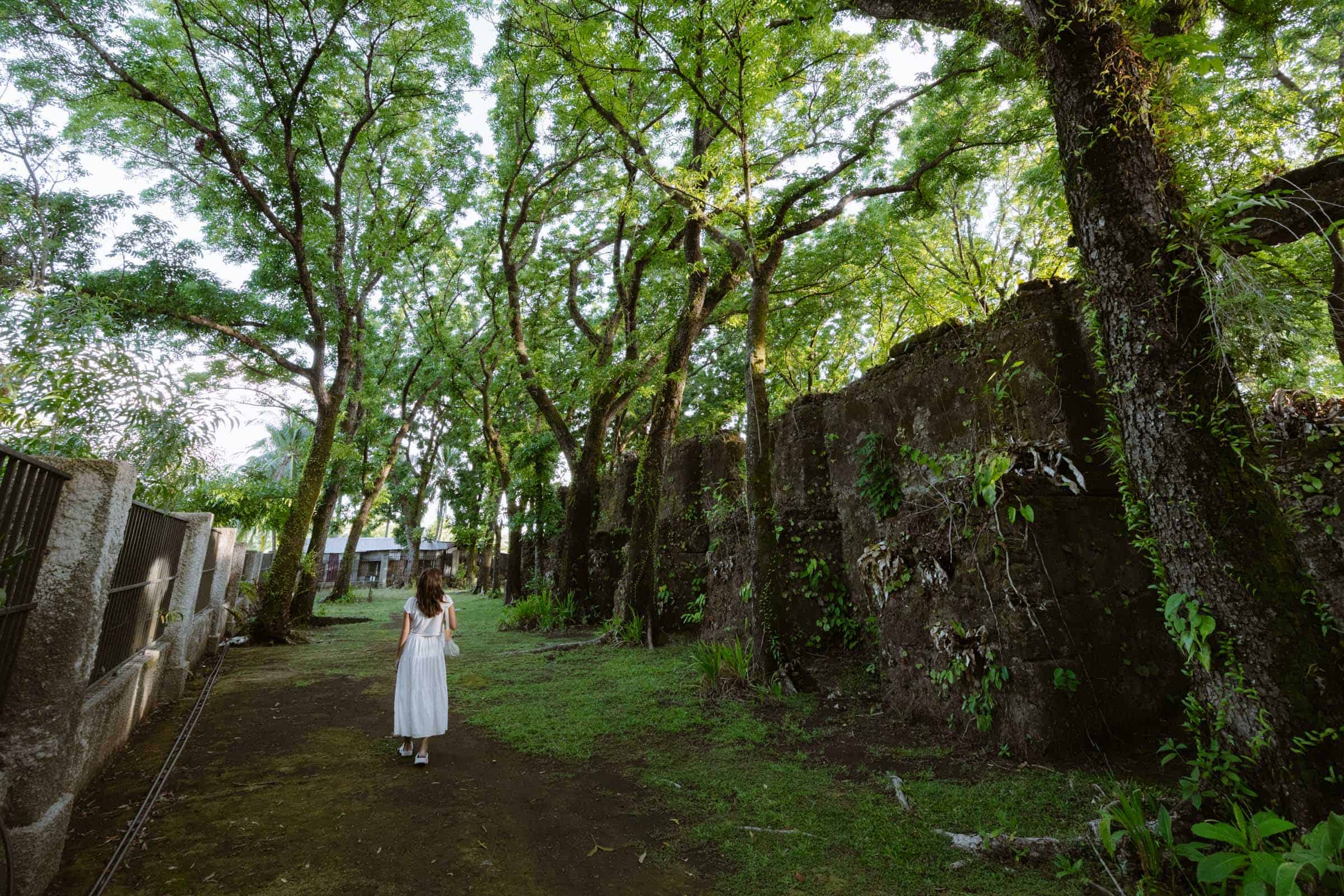
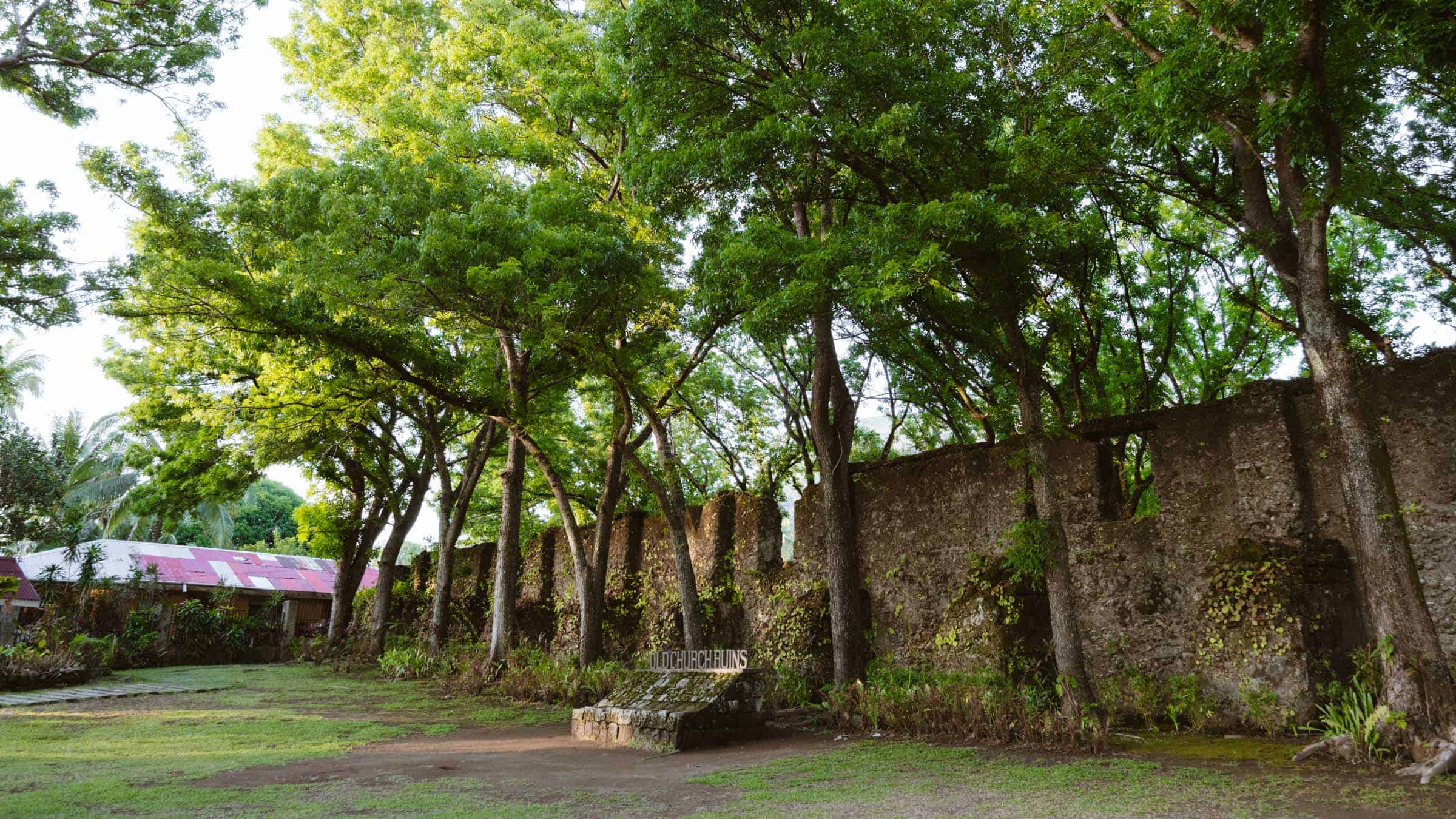

Sto Nino Cold Spring
The Sto Nino Cold Spring is the largest cold spring we’ve been to in the Philippines. The place is completely built out. The entrance has multiple vendors selling everything you need for a day in the cold spring, including clothing, swim gear, and snacks.
After parking our motorbike, we paid the 75 pesos per person entry fee at the gate before heading inside. We found a spot on one of the benches, set down our things, and jumped in the pool.
Upon diving in, the first thing I noticed was that the water was incredibly clear. I could see people swimming underwater. The pool was massive so I thought it would be neat to just swim across the pool.
The pool itself is surrounded by huts and seating areas, and there were plenty of Filipino families posted up with food for a fun day in the cold spring.

Read our full blog post: Sto Niño Cold Spring in Camiguin: Complete Guide
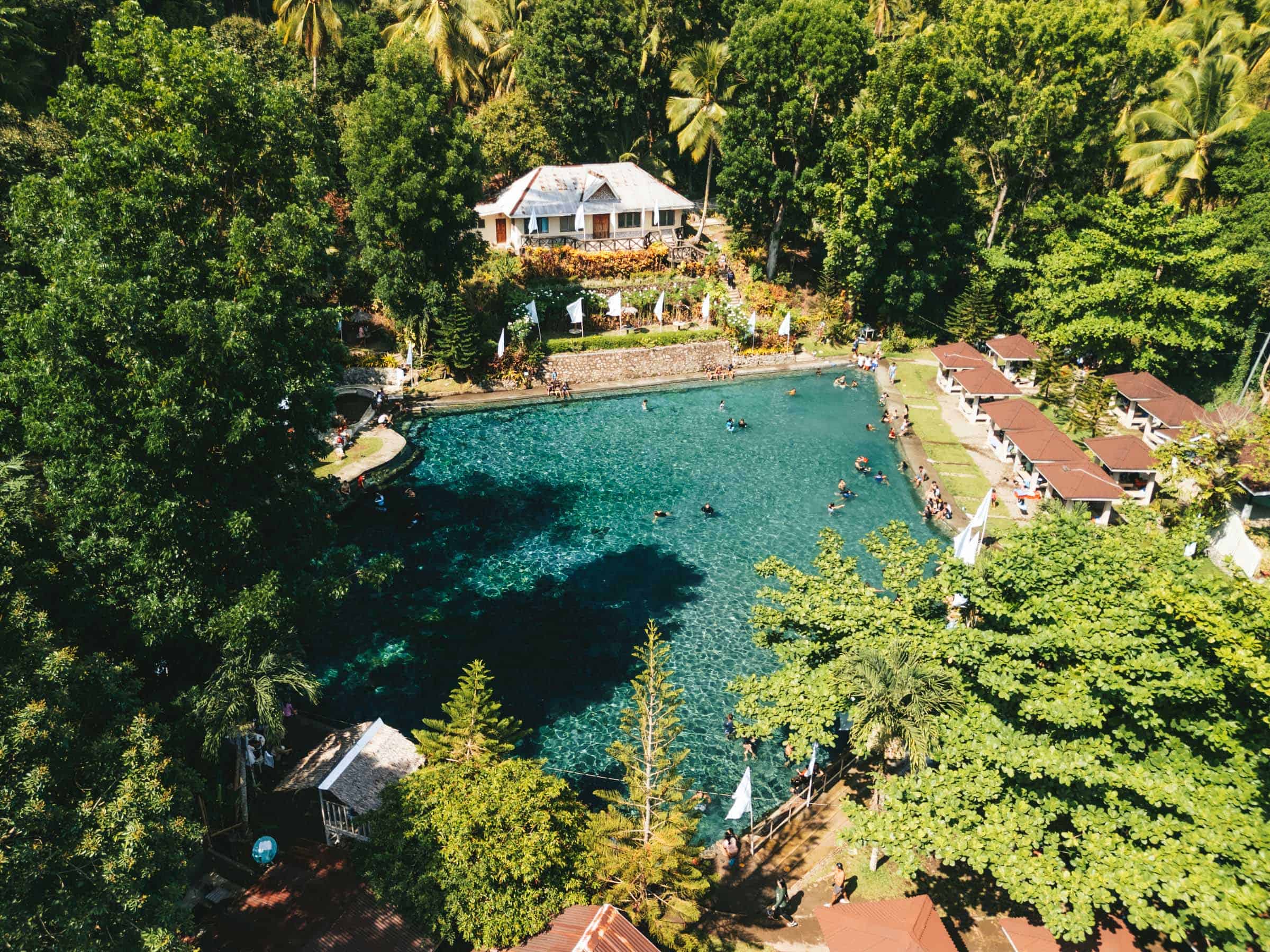
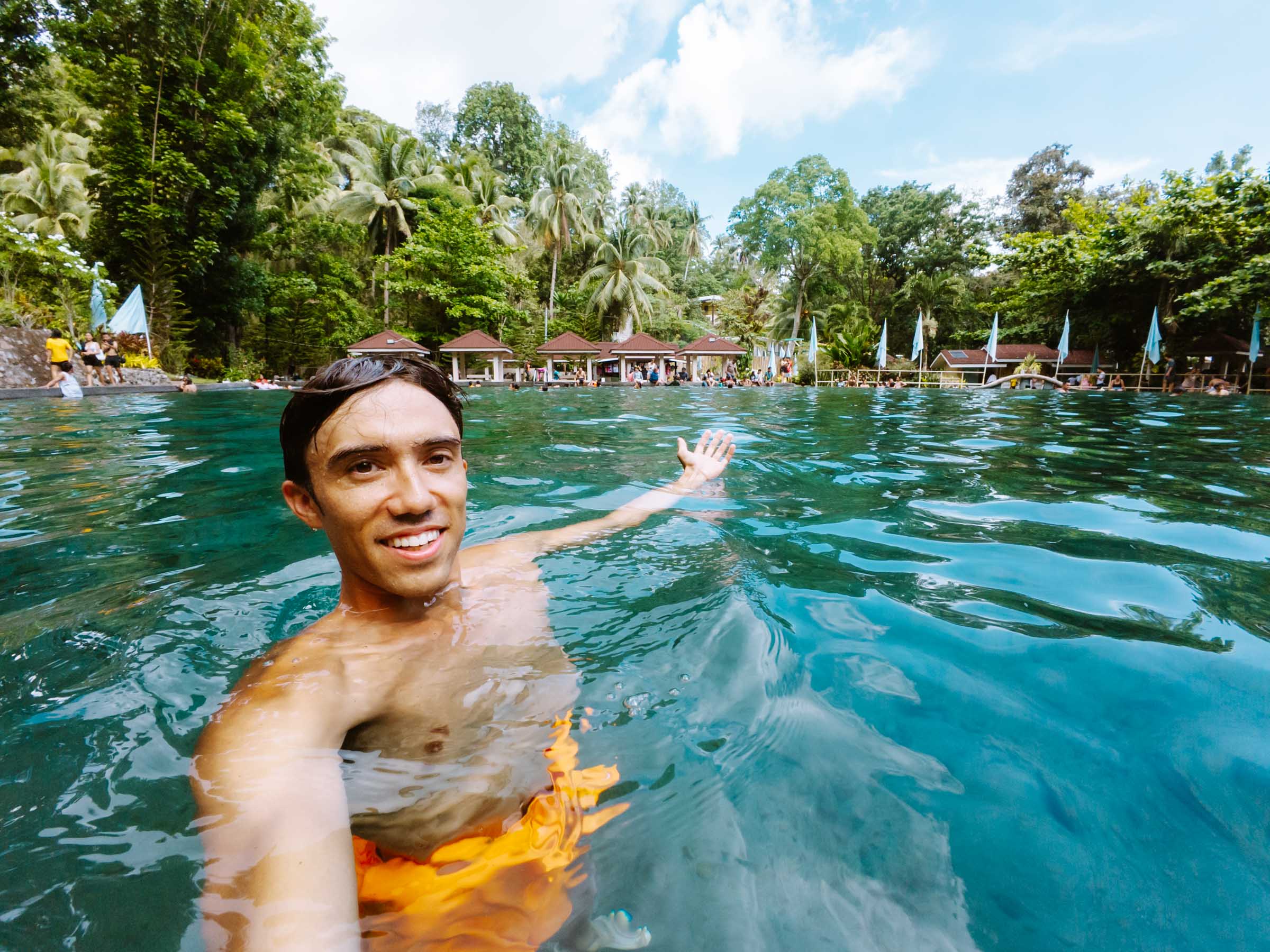
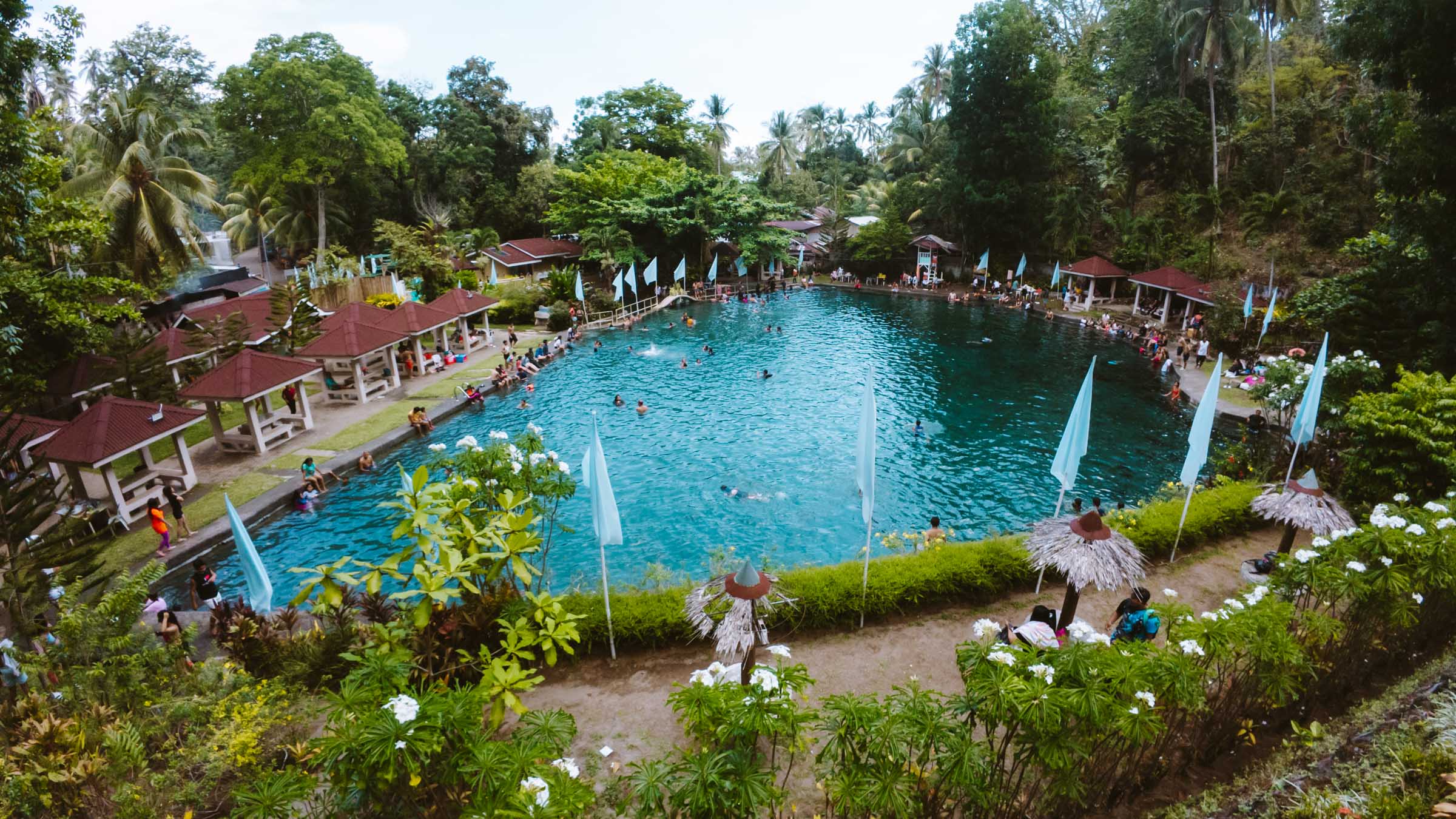
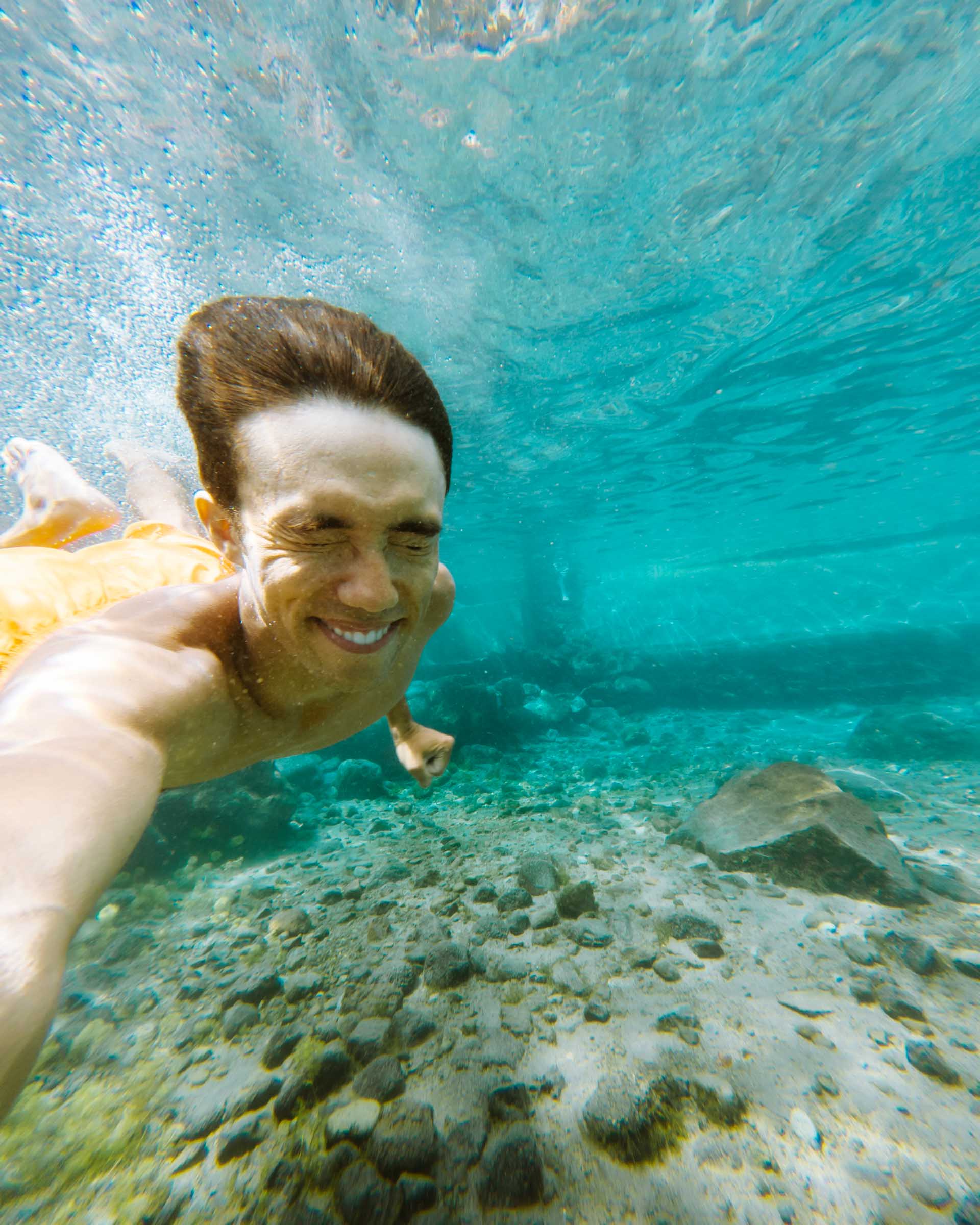
Moro Tower
Moro Tower is located in the southern part of Camiguin. It got its name not from the area that it’s located in, but rather the purpose of the tower. The watchtower was built as a defense against the Moros, a group of pirates who frequently raided the area, robbing and abducting locals. To prevent this, a watch tower was built to keep an eye out for the Moros.
Moro Tower used to be part of a larger fortress, but the rest of it was demolished to make way for the school that is there today. You’ll find the tower’s narrow entrance behind the school, making it a bit tricky to get to. I’ve included its location on a map below so you can find it.
Visiting Moro Tower is completely free but there isn’t much to do there. We looked around at the tower’s structure and climbed its tiny stairs to look out at the ocean just as the locals did hundreds of years ago to keep an eye out for the Moro pirates.

Read our full blog post: Moro Tower in Camiguin: Complete Guide
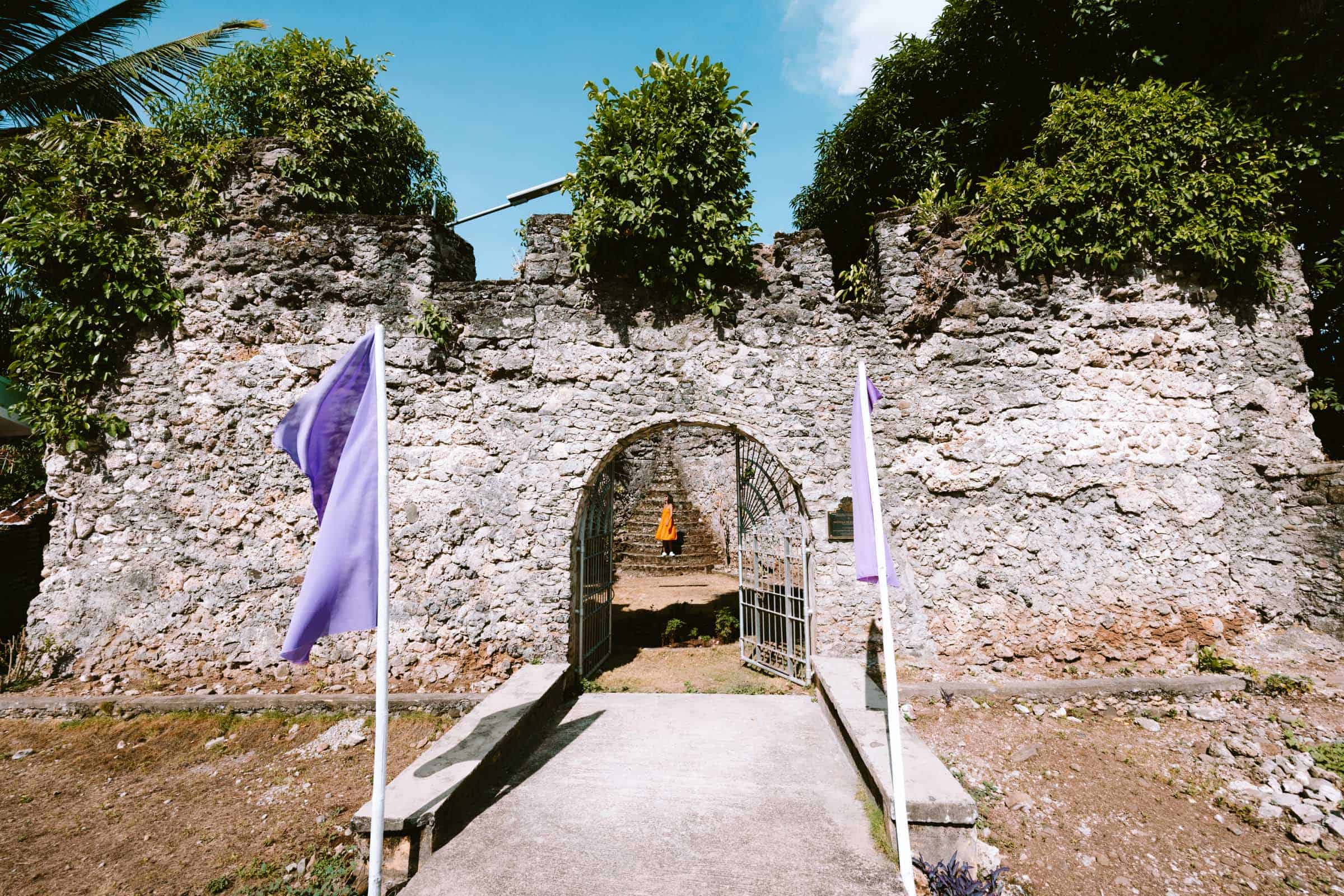

Katibawasan Falls
Katibawasan Falls is the tallest waterfall in Camiguin. At 70 meters tall, it has a picture-perfect single-drop cascade into an emerald pool of water below.
The area around Katibawasan Falls is built up and there are multiple souvenir and snack shops at its entrance. Once you go through the gate to get to the waterfall it has a few huts and benches, and a long concrete staircase to get down to the base of the waterfall.
We saw a few families there swimming in the pool below the falls and taking pictures. At the waterfall, you can hang out and go for a swim, but there isn’t much else to do there.

Read our full blog post: Katibawasan Falls in Camiguin: Complete Guide
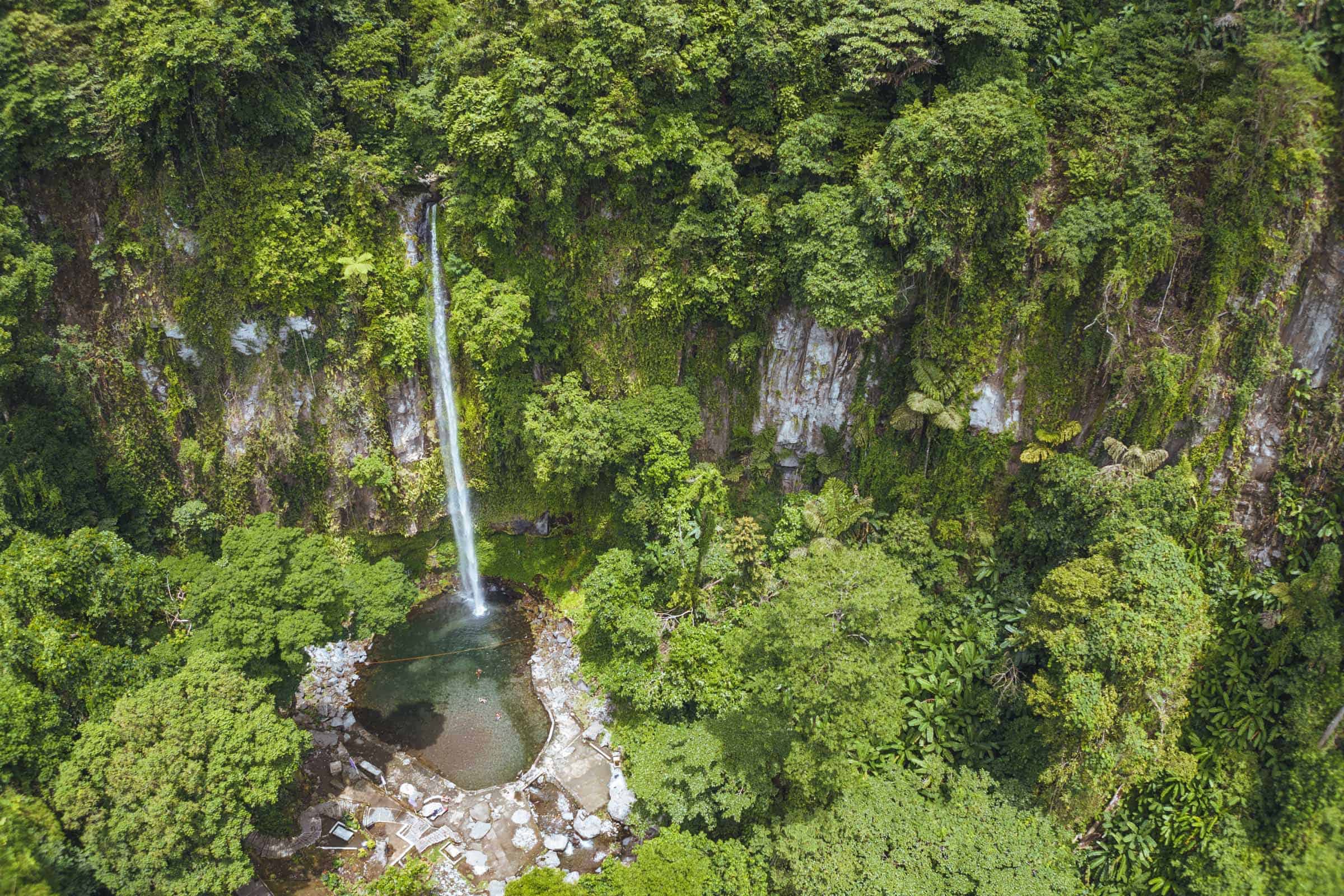
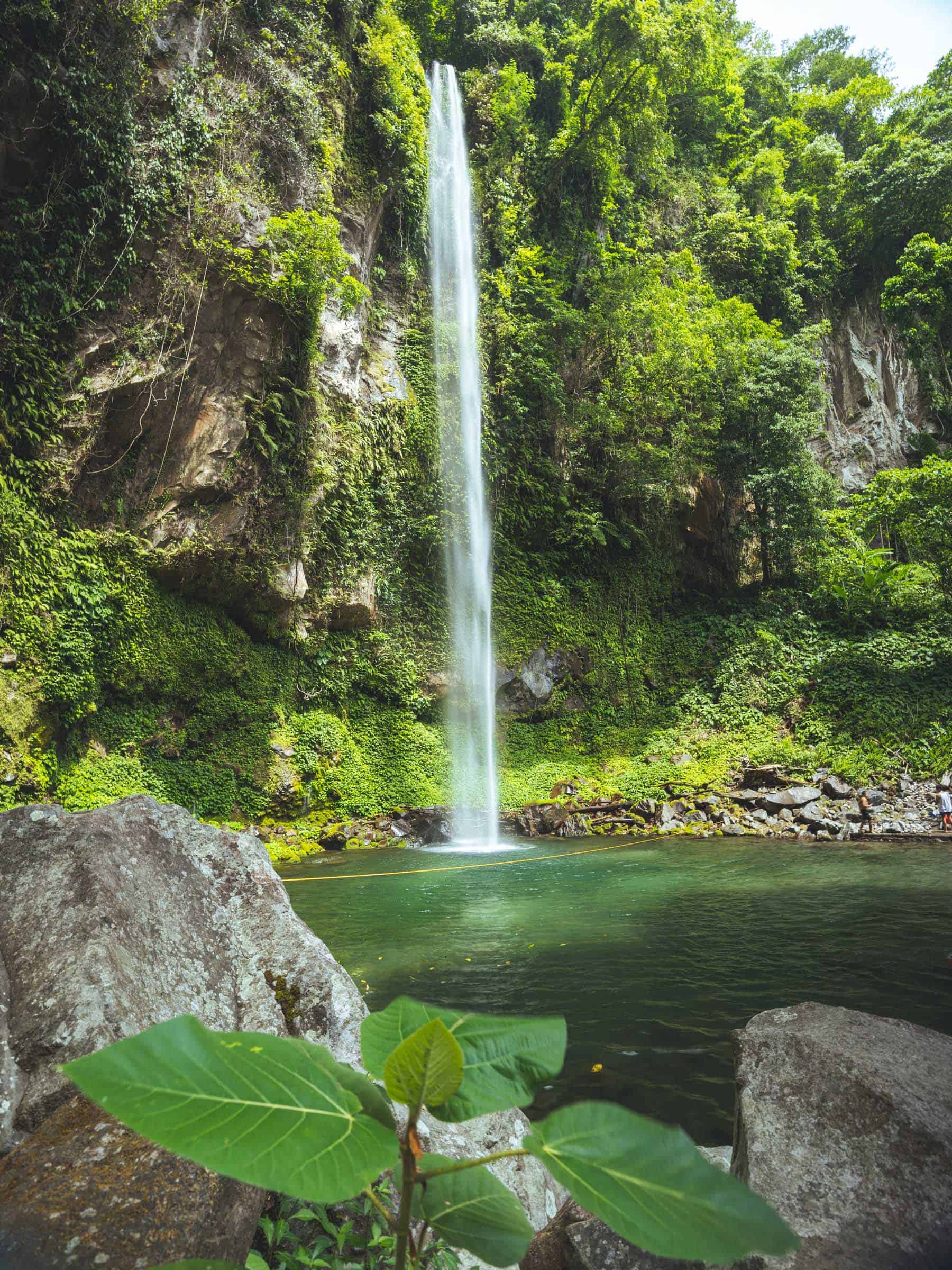

Parola
Camiguin’s main port was originally located in Mambajao before it moved to Benoni. One of the remnants of this old port is its parola, or lighthouse, which now serves as a public park known simply as Parola.
Parola is a small plaza in Mambajao that serves as a meeting ground for people and a place for kids to play. We visited Parola one evening for sunset and it was a nice place to sit for an hour, eat some snacks, and meet some locals.
As I walked around with my camera, a group of kids playing volleyball shouted, “Picture! Picture!” It’s a common experience in the Philippines, and I’m always glad to be someone’s impromptu photographer.
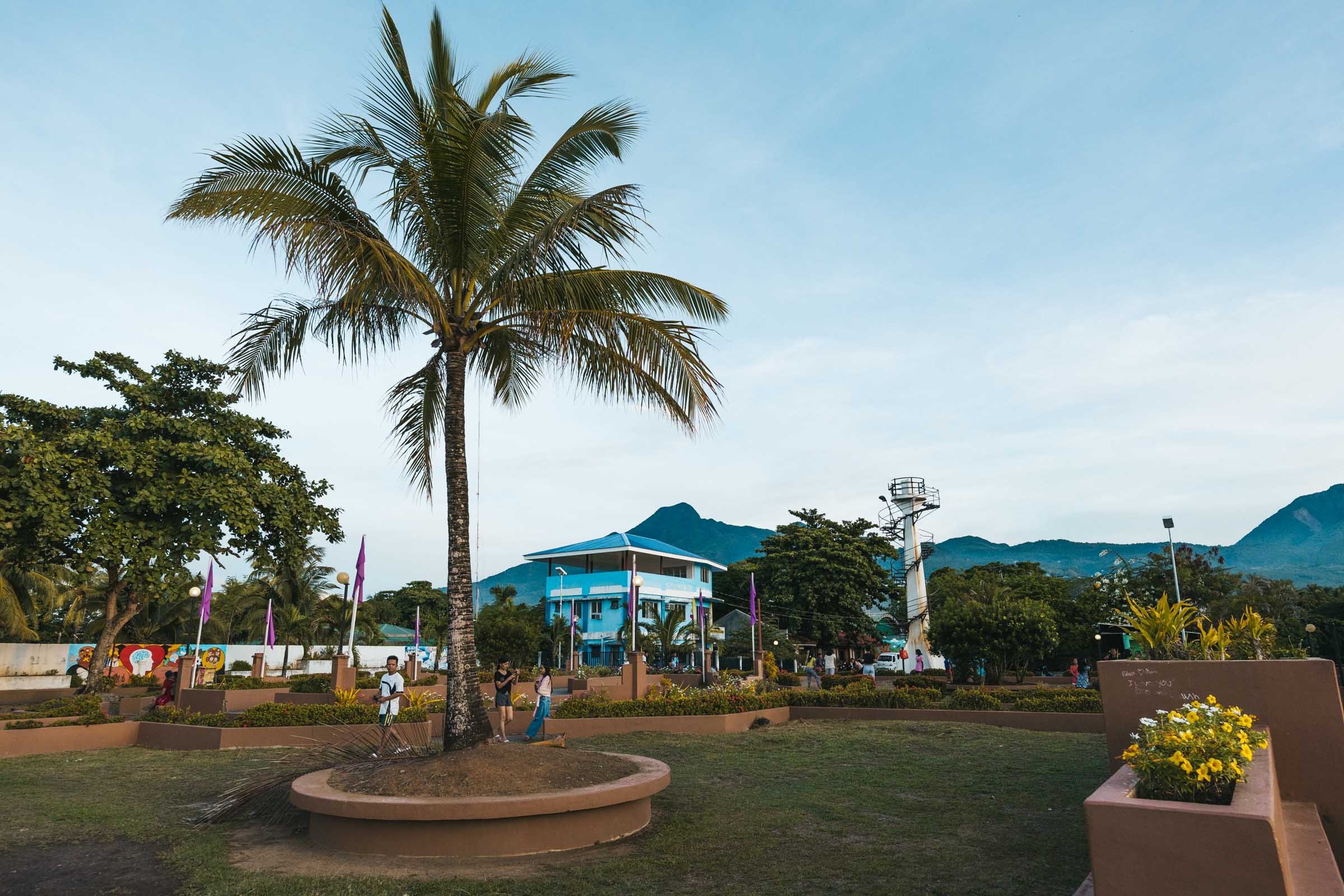
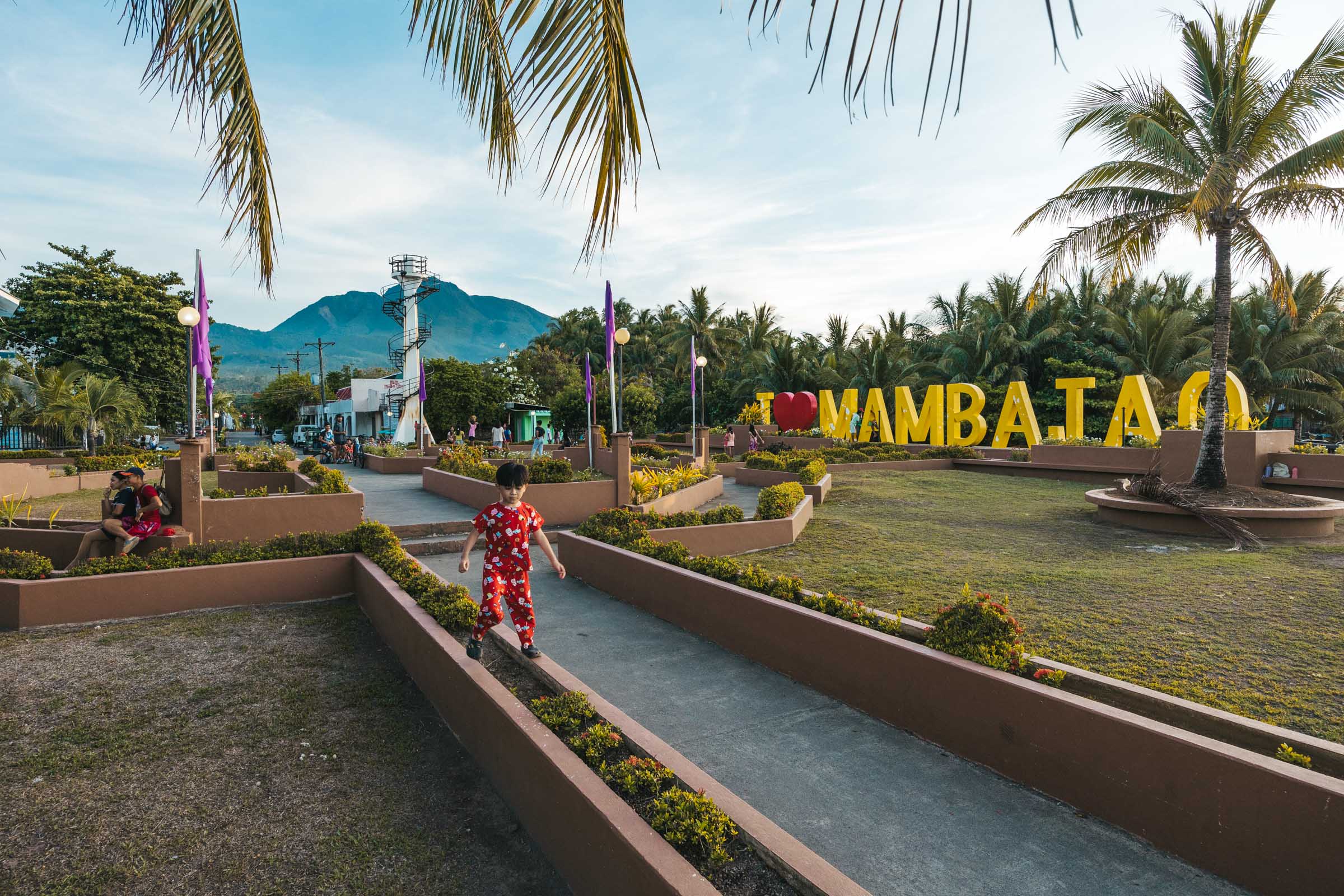
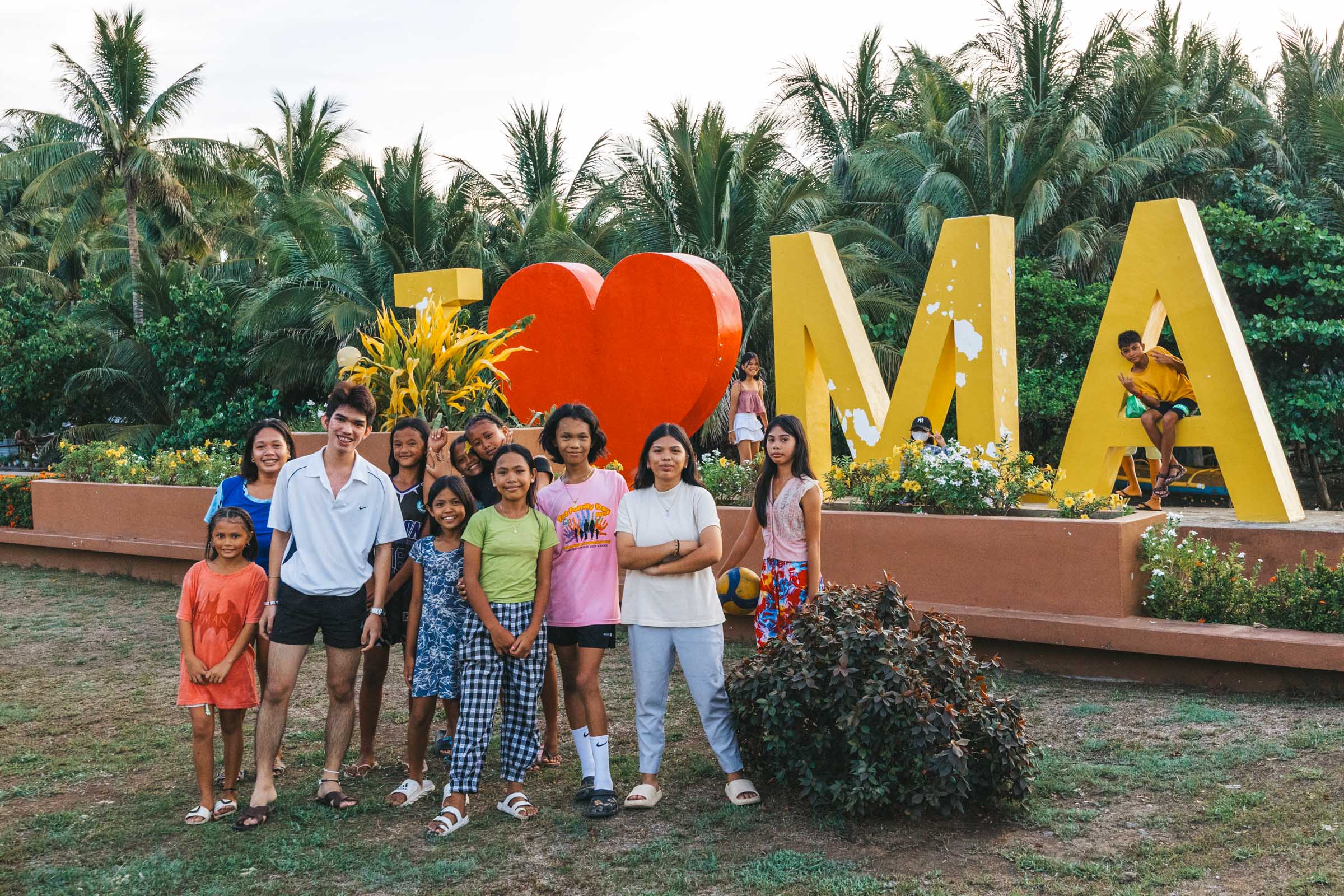
Tongatok View Deck
One of Camiguin’s popular viewpoints is a small pullout along the road overlooking Tongatok Bay. There are no signs or buildings marking the spot, so you won’t even expect that its a viewpoint unless you’re looking for it.
We stopped at the Tongatok Bay View Deck a few times while exploring Camiguin to take a break from riding and soak in the views of the bay and cliffs. It’s a low-key spot, perfect for a quick pause to enjoy the scenery.
If you’re searching for the exact spot, the Tongatok View Deck is listed as “Chan Lookout Point” on Google Maps.

Read our full blog post: Tongatok View Deck in Camiguin: Complete Guide
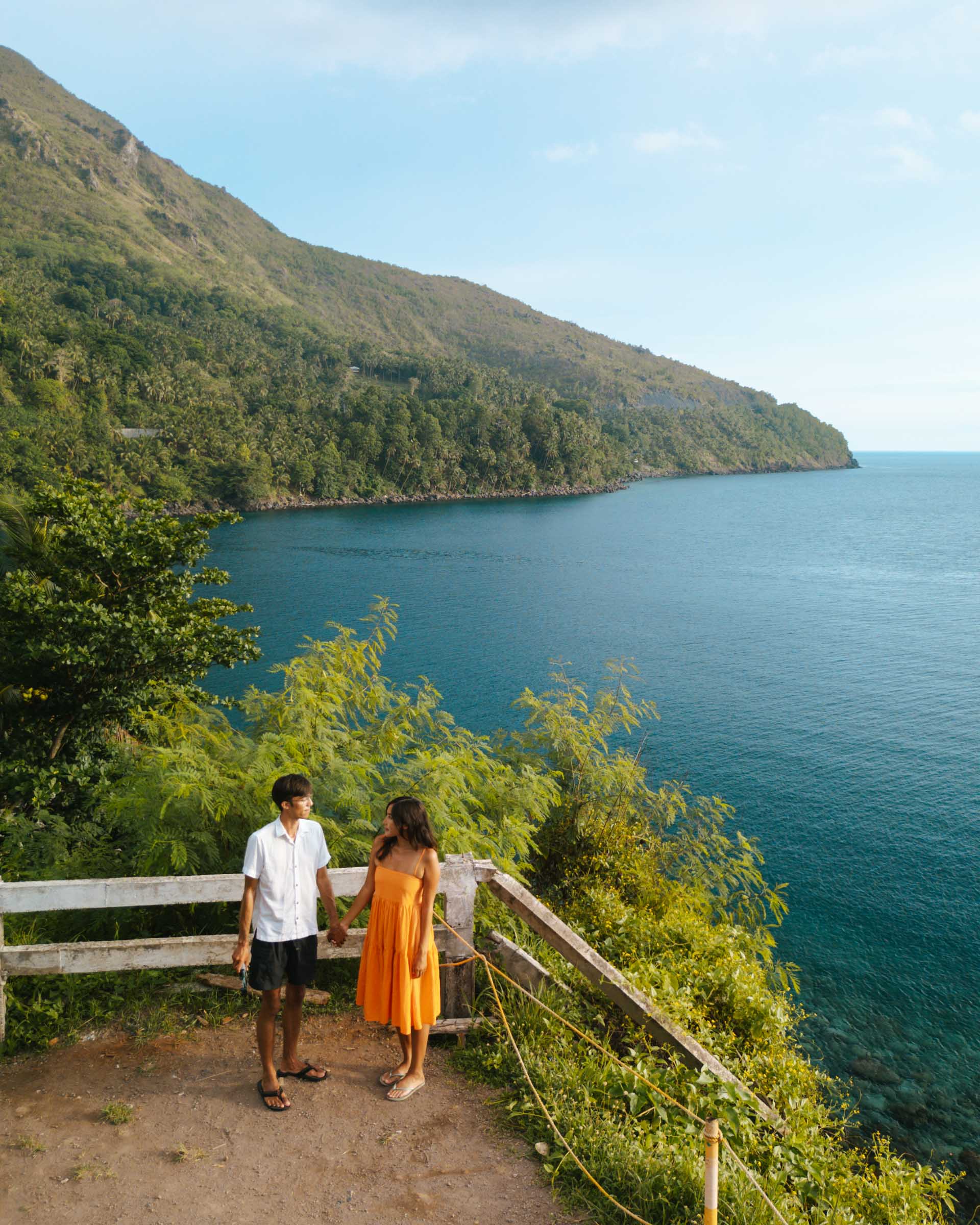
Binangawan Falls
Binangawan Falls is a lesser-known waterfall in Camiguin and one that requires an adventure to get to.
Firstly, the waterfall is located deep in the mountains of Sagay, in the southern part of Camiguin. The road to get to Binangawan Falls is super steep, by far the steepest road we traveled on in Camiguin.
The trail itself is super steep, narrow, and unmaintained. We managed to find the path but made the rookie mistake of attempting the hike after it rained. The rain made the trail muddy and slippery, but it also brought out an unwelcome surprise: leeches.
When we were halfway down the trail Chloe got bit by a leech on her ankle. It was already a tough enough hike and our first-ever leech encounter wasn’t helping things. When this happened I knew it was game over and time to turn around. We went back to our motorbike and rode home, defeated.
If you manage to make it to Binangawan Falls please let us know how it is because we didn’t make it there. Here are some photos from our short hike to give you an idea of the trail.
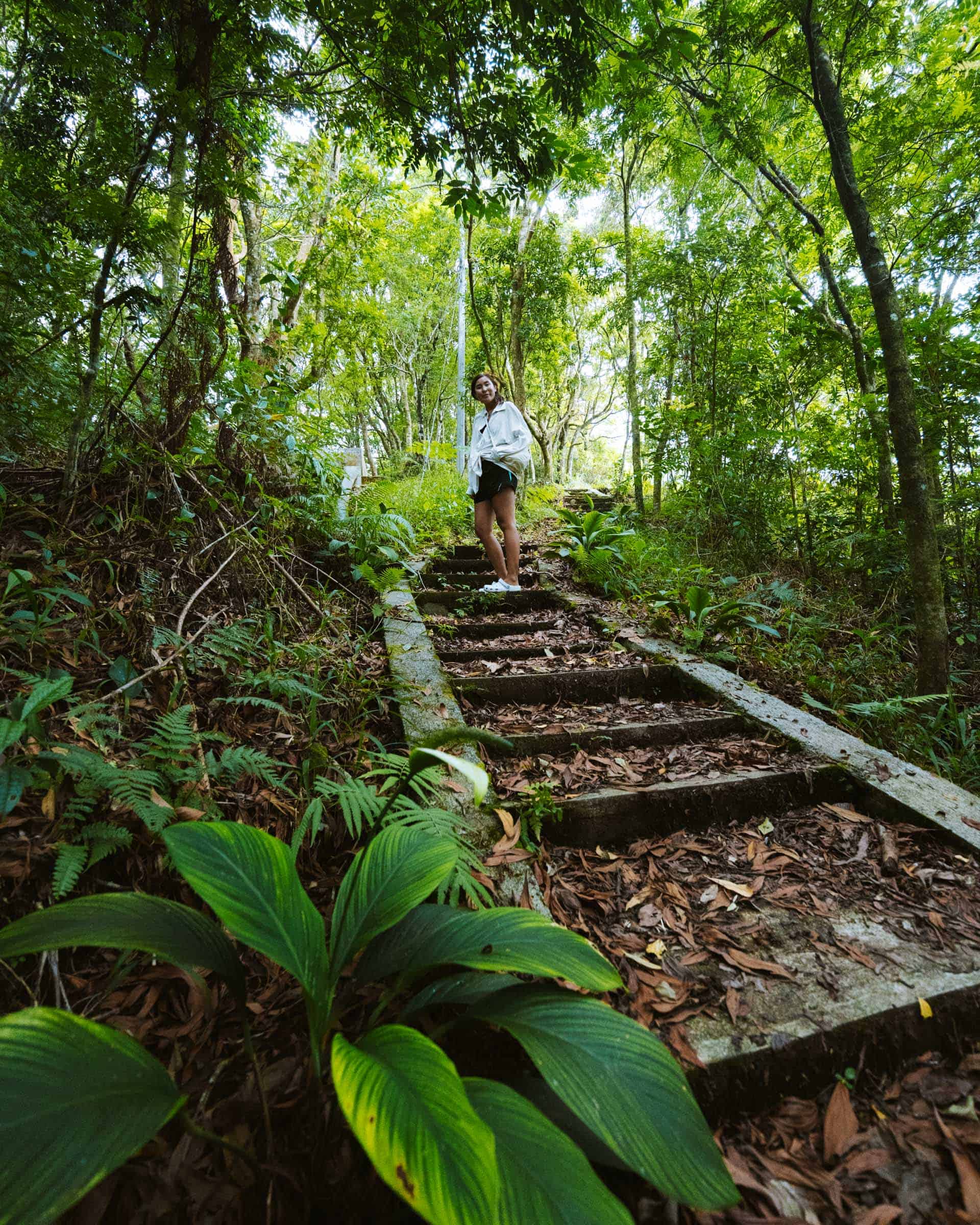
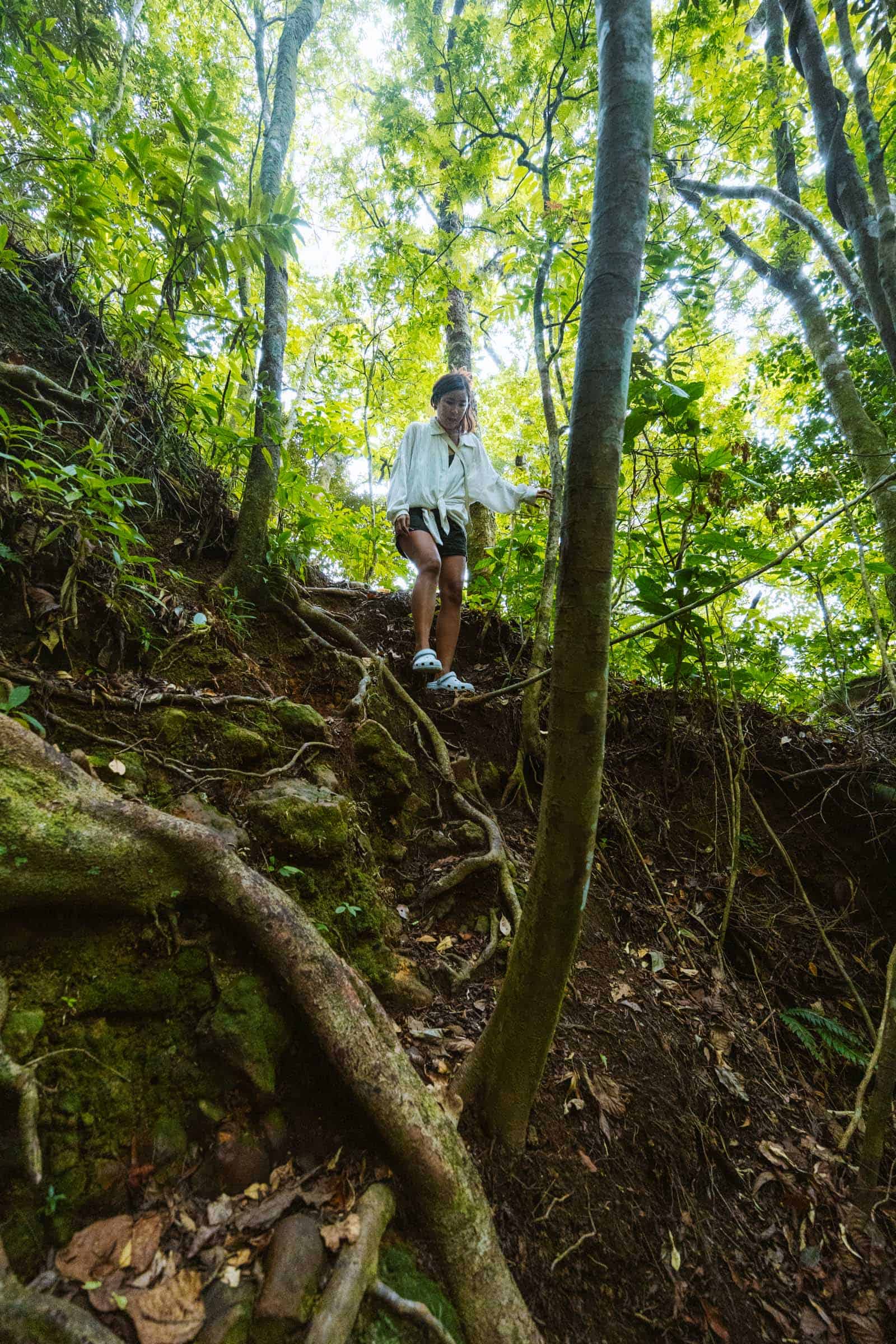
How to Get to Camiguin
Camiguin has its own airport, with two daily flights from Cebu City. We flew to Camiguin from Siargao, connecting through Cebu, and had no issues getting there. It’s a convenient option if you’re flying in from nearby islands.
There are two ferries that travel to Camiguin: one from Bohol and one from Mindanao.
The ferry from Bohol leaves from Jagna and arrives at Balbagon port in Camiguin. The ferry from Mindanao departs from Balingoan Port and arrives at Benoni Port in Camiguin.
No matter how you plan to get to Camiguin, you’ll need to register online at islevisitcamiguin.com beforehand to get a QR code. This is a leftover from COVID-era tracking, but the local government now uses it to monitor tourism statistics. If you forget to do this before arriving, you’ll have to register once you arrive in Camiguin.
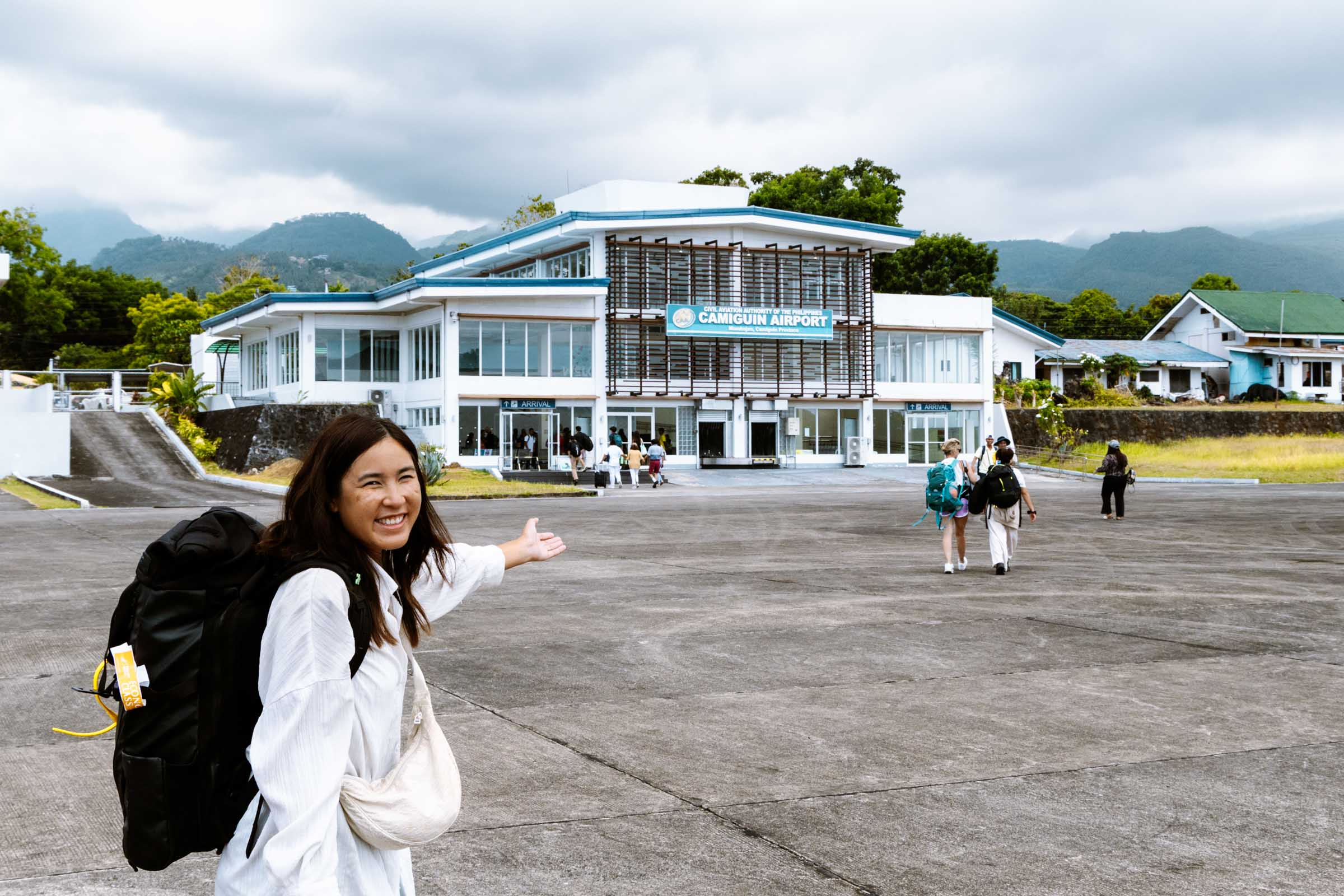
How to Get Around Camiguin
The best way to get around Camiguin is by motorbike. It gives you the most freedom to explore the island at your own pace, and since Camiguin isn’t that big, you can easily reach almost any destination. We rented a motorbike in Mambajao for 350 pesos per day for our adventures around the island.
Another option is to use local transportation like jeepneys, tricycles, or tuk-tuks. However, you’ll be limited by their schedules, and since Camiguin is quite rural, there aren’t many of them driving around.
Read our full blog post: Renting a Motorbike in the Philippines: Complete Guide
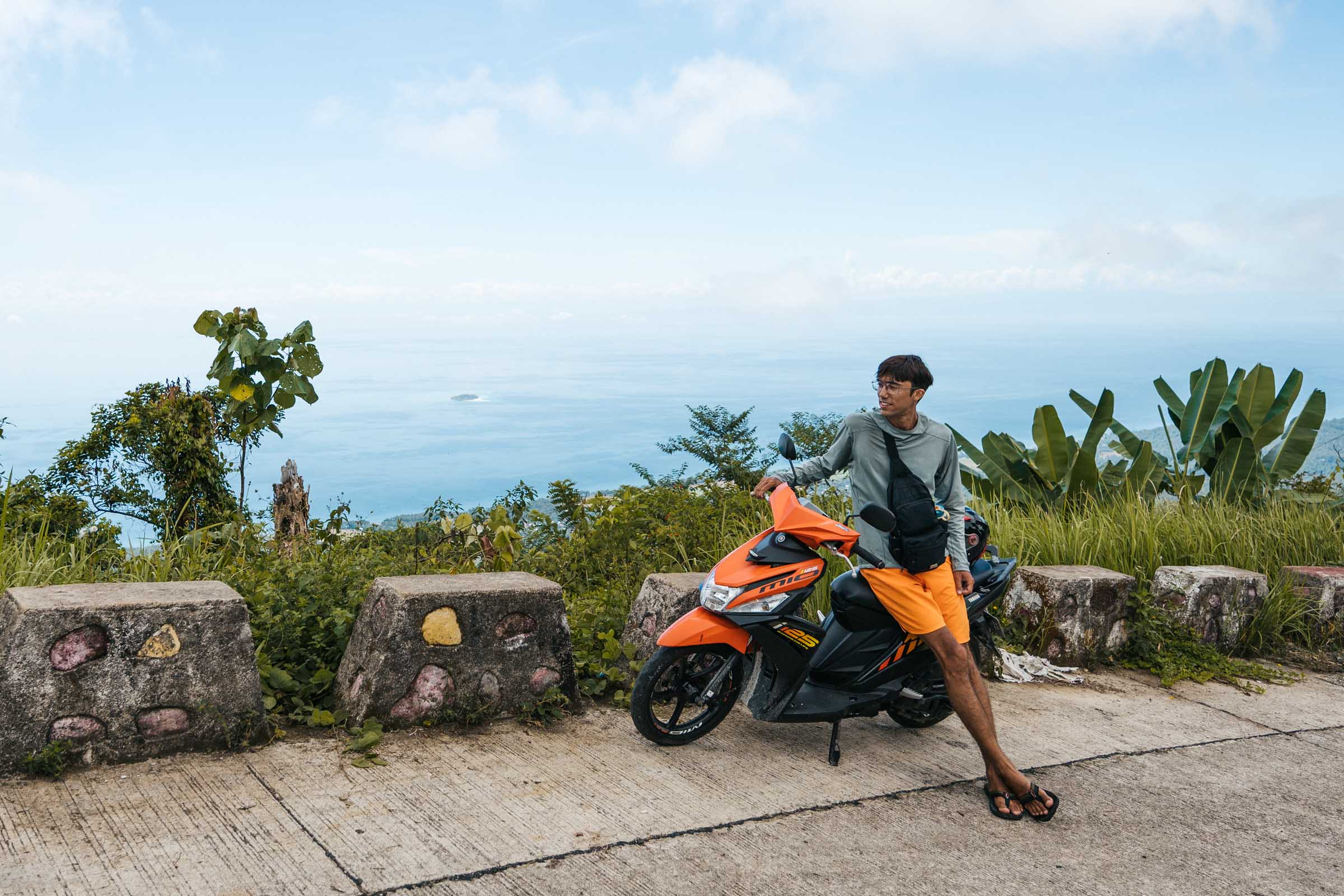
Where to Eat in Camiguin
Camiguin is getting more and more popular as a tourist destination, so all sorts of restaurants have popped up around the island. Camiguin is popular with Italian expats, so there are quite a few Italian restaurants on the island.
Here is a list of restaurants that we personally ate at and recommend:
- Hayahay Cafe: Serving Western-style cafe food, Hayahay Cafe was our favorite restaurant in Camiguin, and we ate here almost every day for breakfast. Their portions are huge, so we split an entree and a coffee between the two of us. There are also vegan and vegetarian options.
- La Dolce Vita: We had dinner at La Dolce Vita twice during our stay in Camiguin and it was wonderful both times. They use quality ingredients in their pizza and their spaghetti ragu was delicious!
- Utopia Cafe: Good coffee, tasty pastries, and an amazing view.
- Guerrera Restaurant: If you are looking for something different, Guerrera Restaurant serves Thai food and has a nice atmosphere but is a bit on the pricier side for the Philippines.
- Sapore Ristorante Camiguin: We ate dinner here on our last night in Camiguin and would have gone more if we had known about it sooner! They serve authentic Italian food, with homemade bread and pasta.
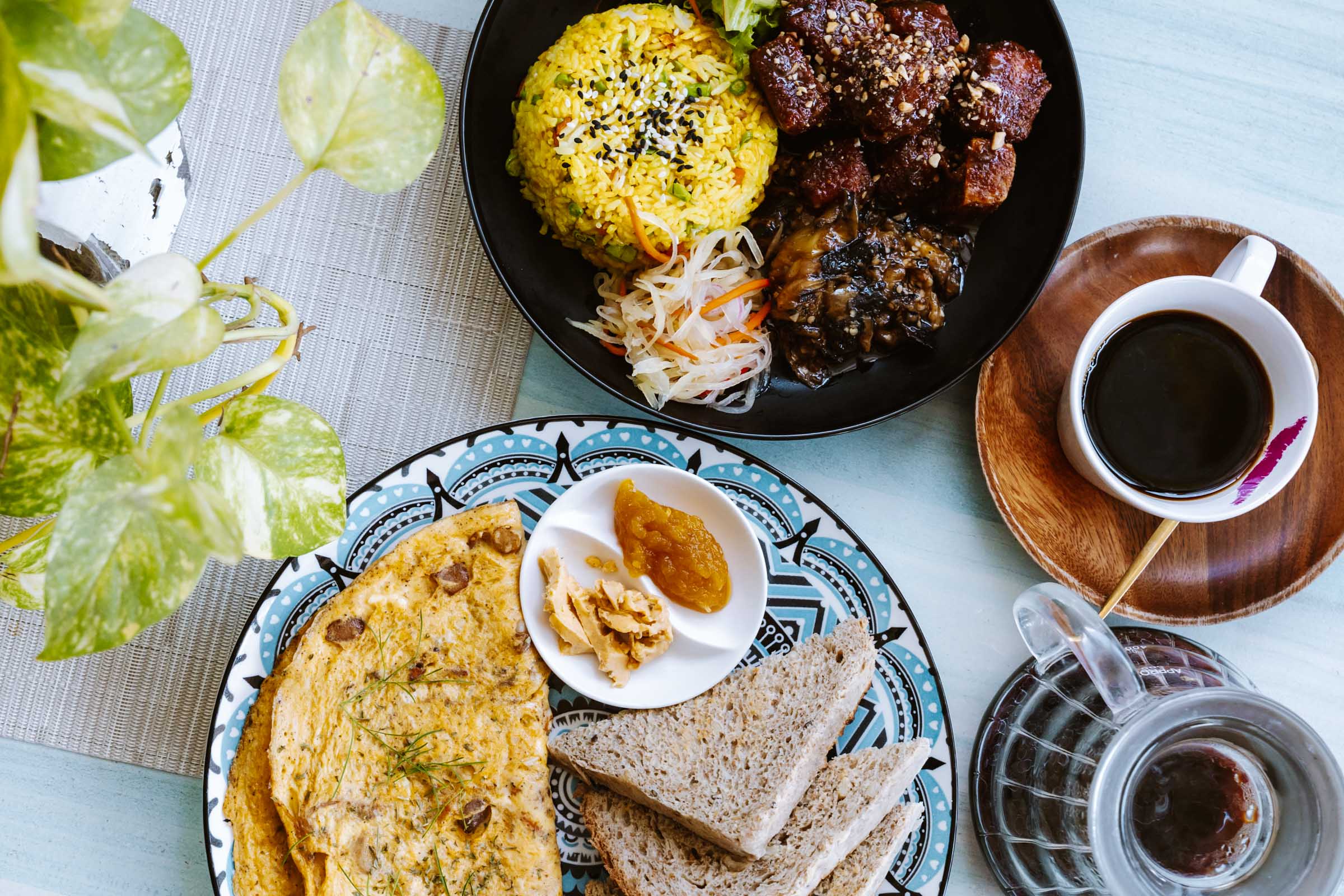
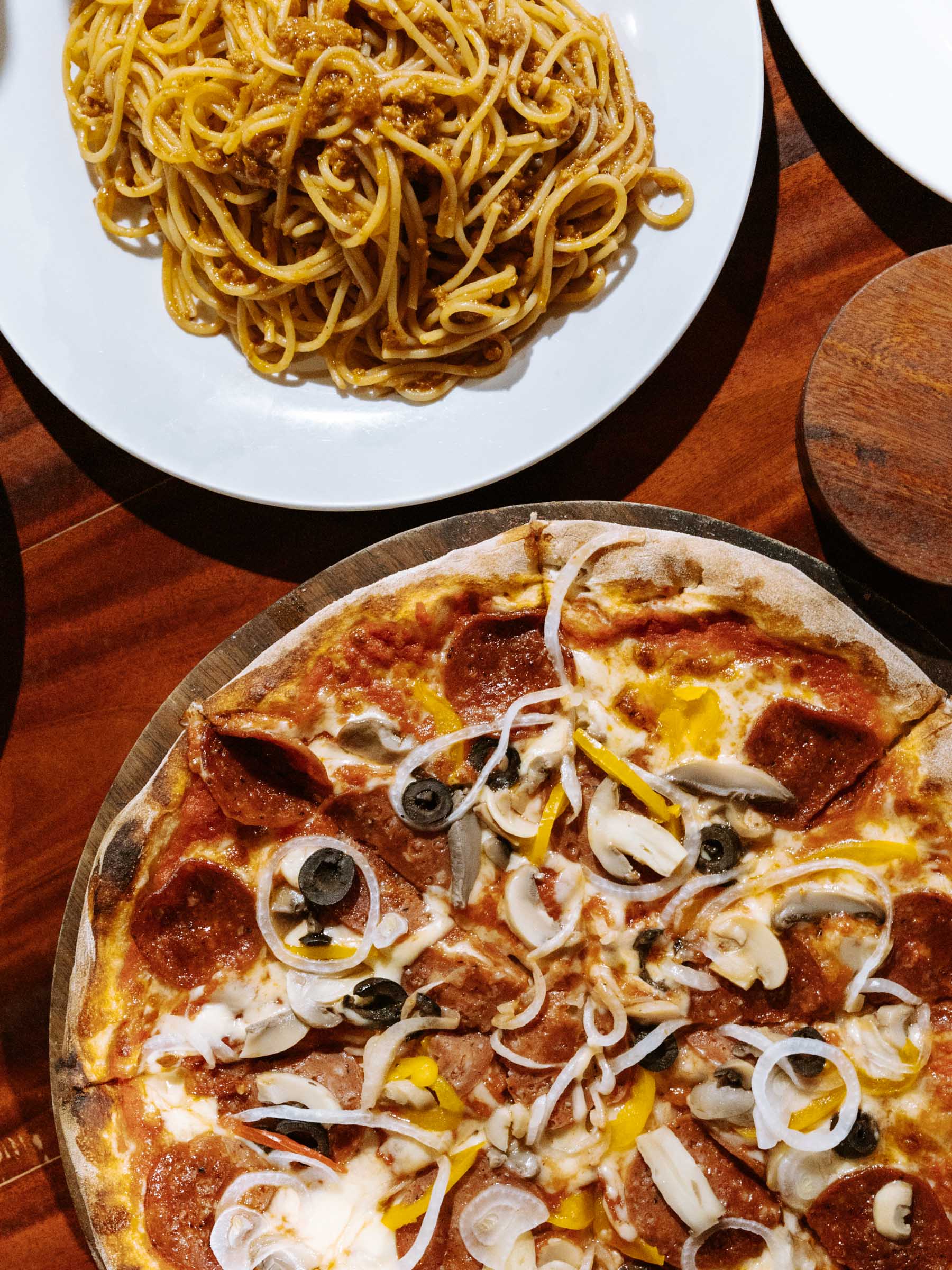
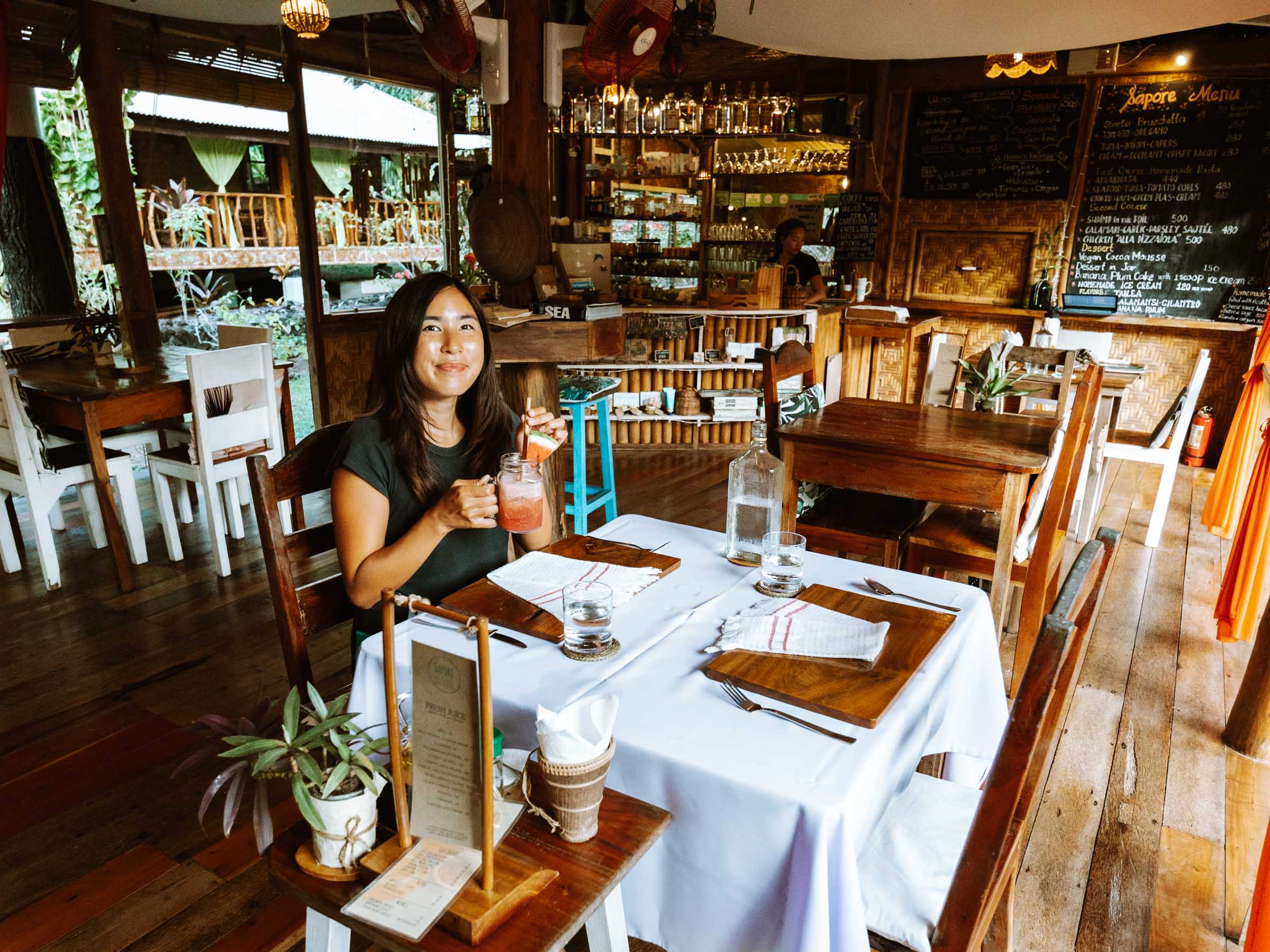
Where to Stay in Camiguin
Most accommodations in Camiguin are located on the north side of the island near Mambajao. This is convenient because Mambajao is the biggest town in Camiguin and has the island’s only airport, making getting to and from Camiguin much easier.
I won’t recommend the place we stayed at because we had a bad experience there. Our door wouldn’t lock from the inside, and someone snuck into our room in the middle of the night and stole my wallet. Luckily, everything in it could be replaced, so it didn’t ruin our trip. I’m just relieved they didn’t take anything more valuable, like our camera.
Here’s where we recommend staying instead:
It’s a place called Nypa Style Resort. We found this place because we had dinner at their restaurant one night, and their staff was kind enough to give us a tour of some of their vacant rooms. This place is set near Mambajao with beautifully kept grounds and immaculately clean rooms.
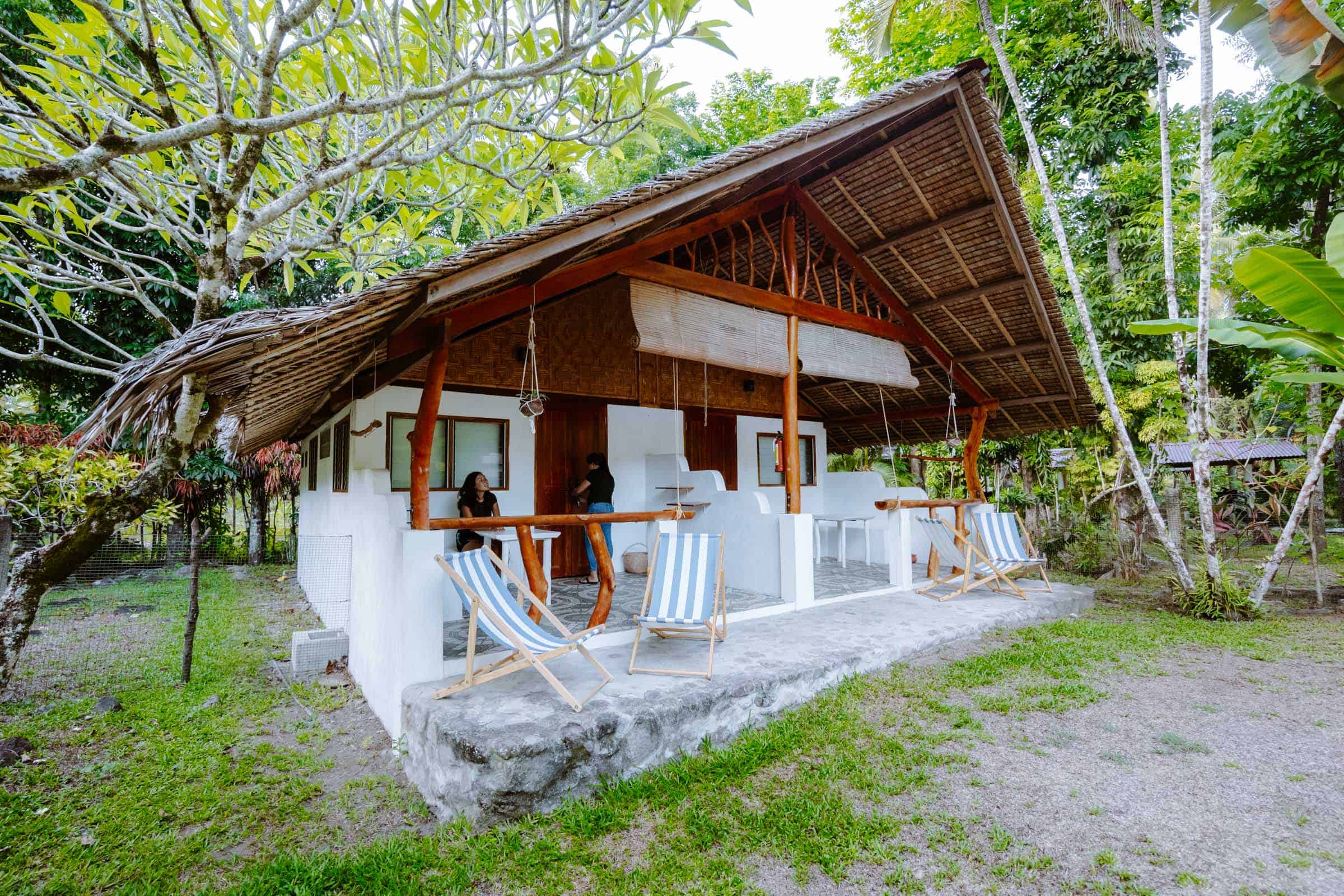
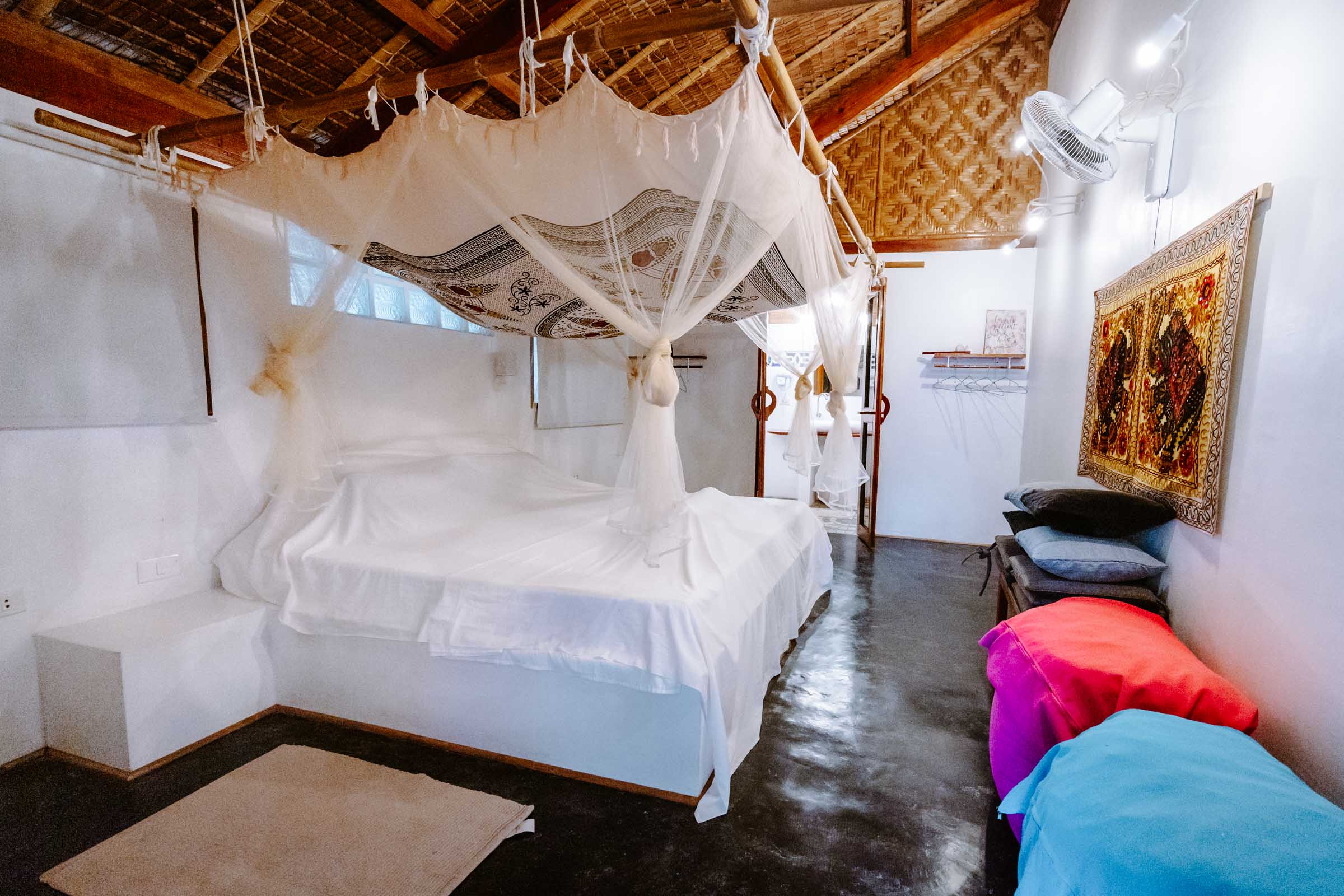
Best Time to Visit Camiguin
The best time to visit Camiguin is during the island’s dry season, which usually lasts from February to May. If you want to enjoy all the beaches, island-hopping, and waterfalls that the island has to offer, this is the ideal time to go.
The rest of the year doesn’t see much more rain than the dry season, so it would be fine to visit any time of year, as long as you’re flexible. We visited Camiguin in June and only experienced a few passing showers, which didn’t stop us from going sightseeing.
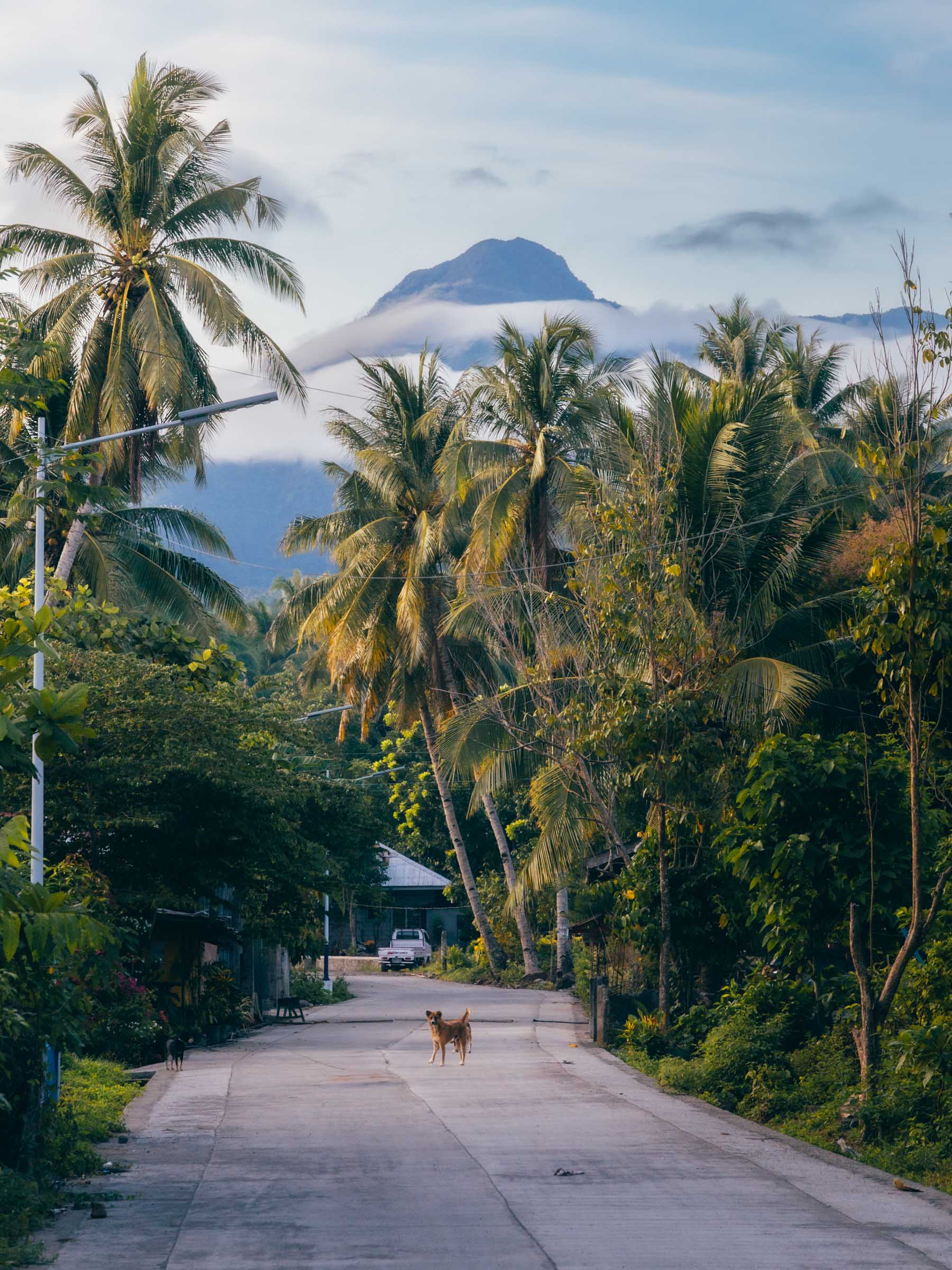

What to Pack for Camiguin
Here are some of our must-have items you might not have thought of when packing for a trip to Camiguin.
- Crocs: During our time in Camiguin, I was so glad to have Crocs to protect my feet when exploring rocky terrain and chasing waterfalls. They are the ultimate shoe in the Philippines for a reason – many Filipinos wear them too!
- Snorkel: With all the amazing snorkeling spots in Camiguin, it helps to have your own snorkel set like this one if you plan to do some underwater activities! Plus, you won’t need to worry about renting a snorkel, which may be of… questionable quality.
- Sunscreen: For some reason, sunscreen is expensive in the Philippines and I’ve even encountered places selling fake sunscreen that doesn’t work! So I recommend bringing your own sunscreen to Camiguin.
- Dry Bag: With all the sand, salt, and water flying everywhere during our adventures, I was so glad to have a dry bag to keep all my things safe from the elements!
- Travel Towel: In my opinion, a travel towel like this one is super necessary for a trip to Camiguin! It packs down nicely and was there for me anytime I went swimming, or just needed to brush sand or dirt off.
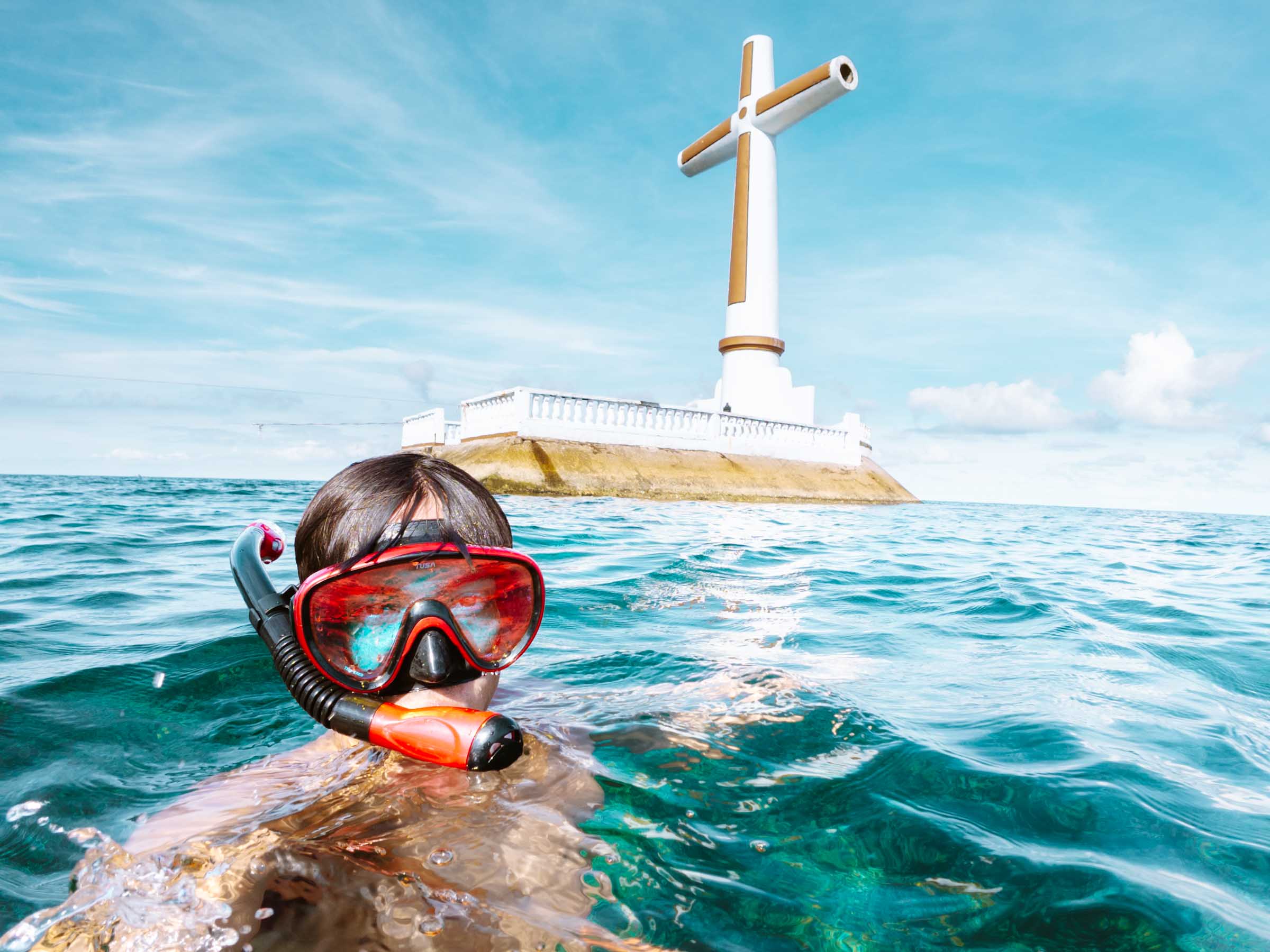
Our Free Camiguin Map
Want a free map of all of the locations mentioned in this post? Sign up in the box below and we’ll deliver one right to your inbox, plus our top tips to help you plan your Camiguin trip!
Are You Following Our Camiguin Blog Series?
We spent 8 days in Camiguin and found so many things to do there—from waterfalls to beaches, cold springs, and coral reefs. To help fellow adventurers, we’ve put together guides to the best places we found. You can check them out by clicking the links below.
- Start planning your trip here: Camiguin Travel Guide
- Our Ultimate Guide to Camiguin: 16 Awesome Things to Do in Camiguin
- How to plan your Camiguin trip: 3 Days in Camiguin: The Perfect Camiguin Itinerary
- Our favorite place to snorkel in Camiguin is The Sunken Cemetery
- Our favorite day trip in Camiguin is Mantigue Island which is just a short boat ride away
- Camiguin’s best beach is at White Island
- Our favorite waterfall in Camiguin is Tuasan Falls
- If you want to walk through the mangroves on a web of boardwalks check out Katunggan Park
- How to rent a motorbike in the Philippines
I hope our guide to all the tourist spots in Camiguin helped you plan your adventure there. Feel free to drop a comment below if you have any questions! 🐸

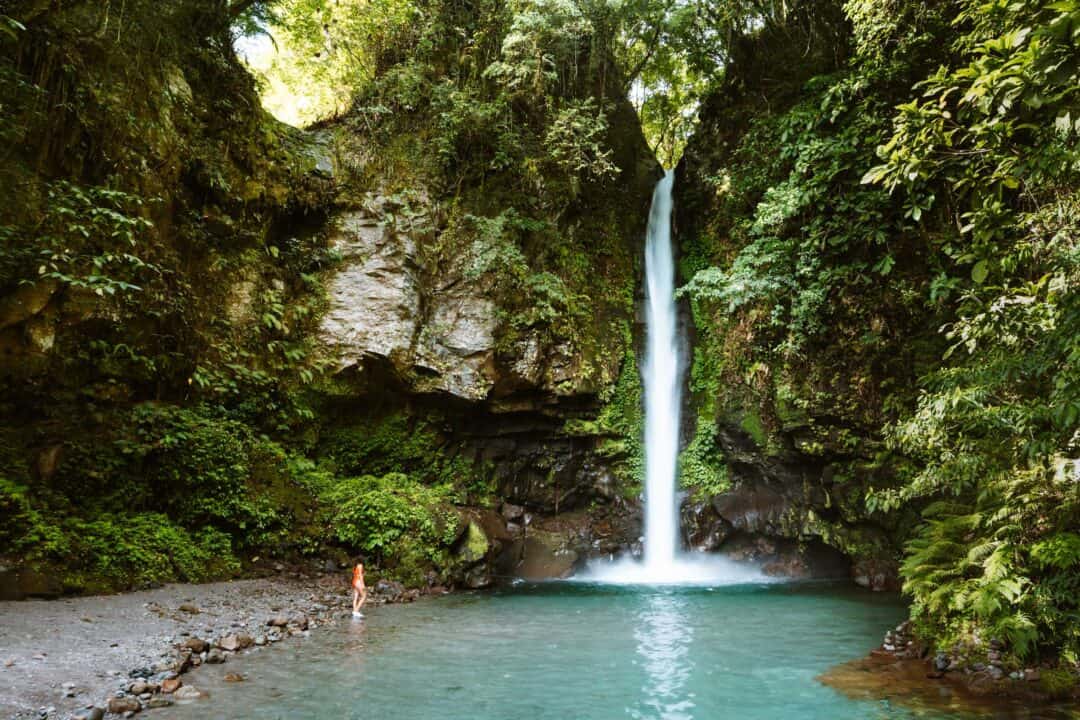


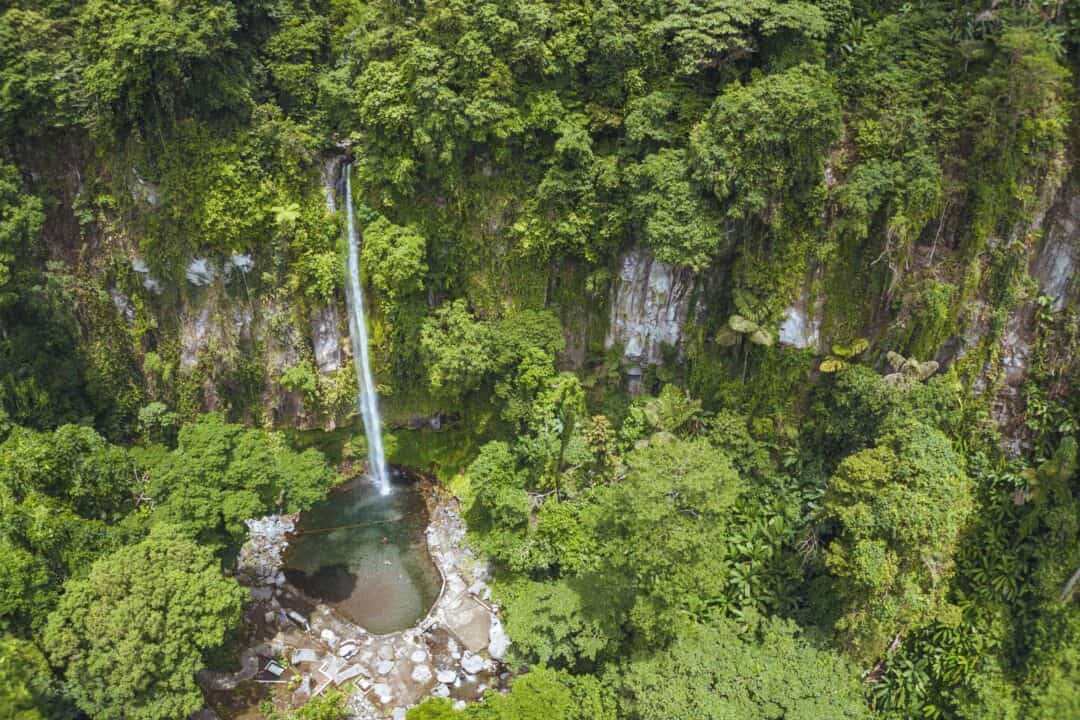
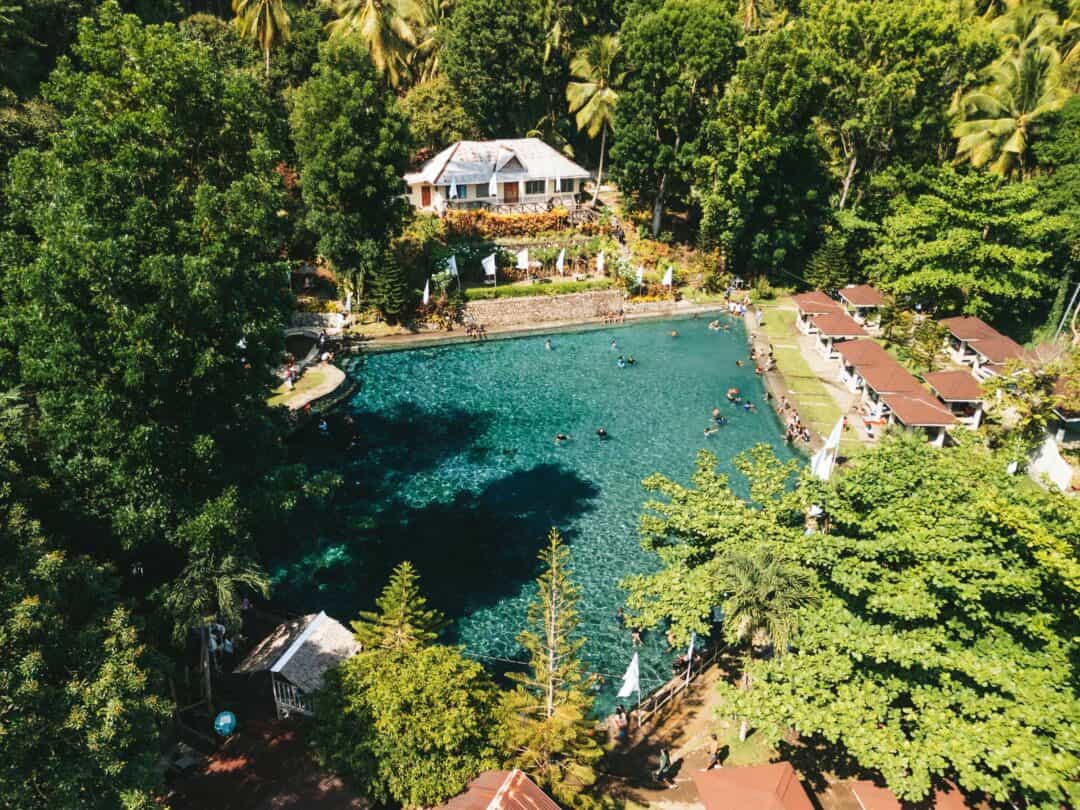
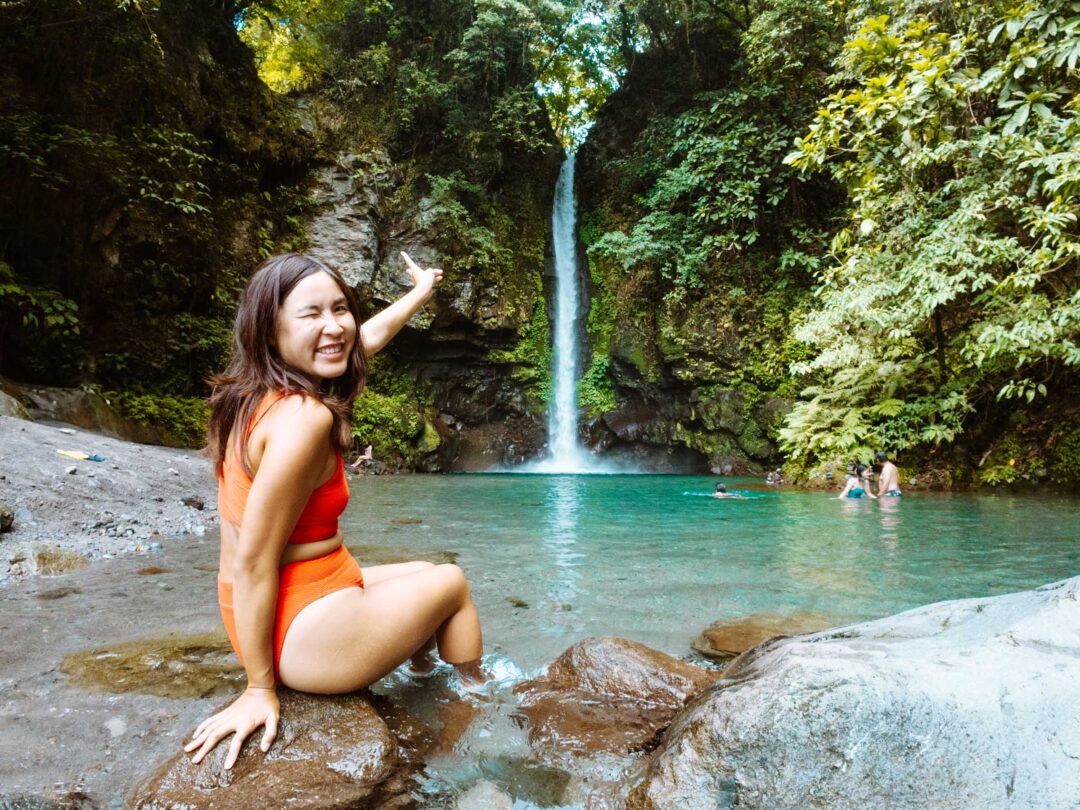


Looks amazing, did you encounter jellyfish in the water?
Thanks for the informative Camiguin Blog.